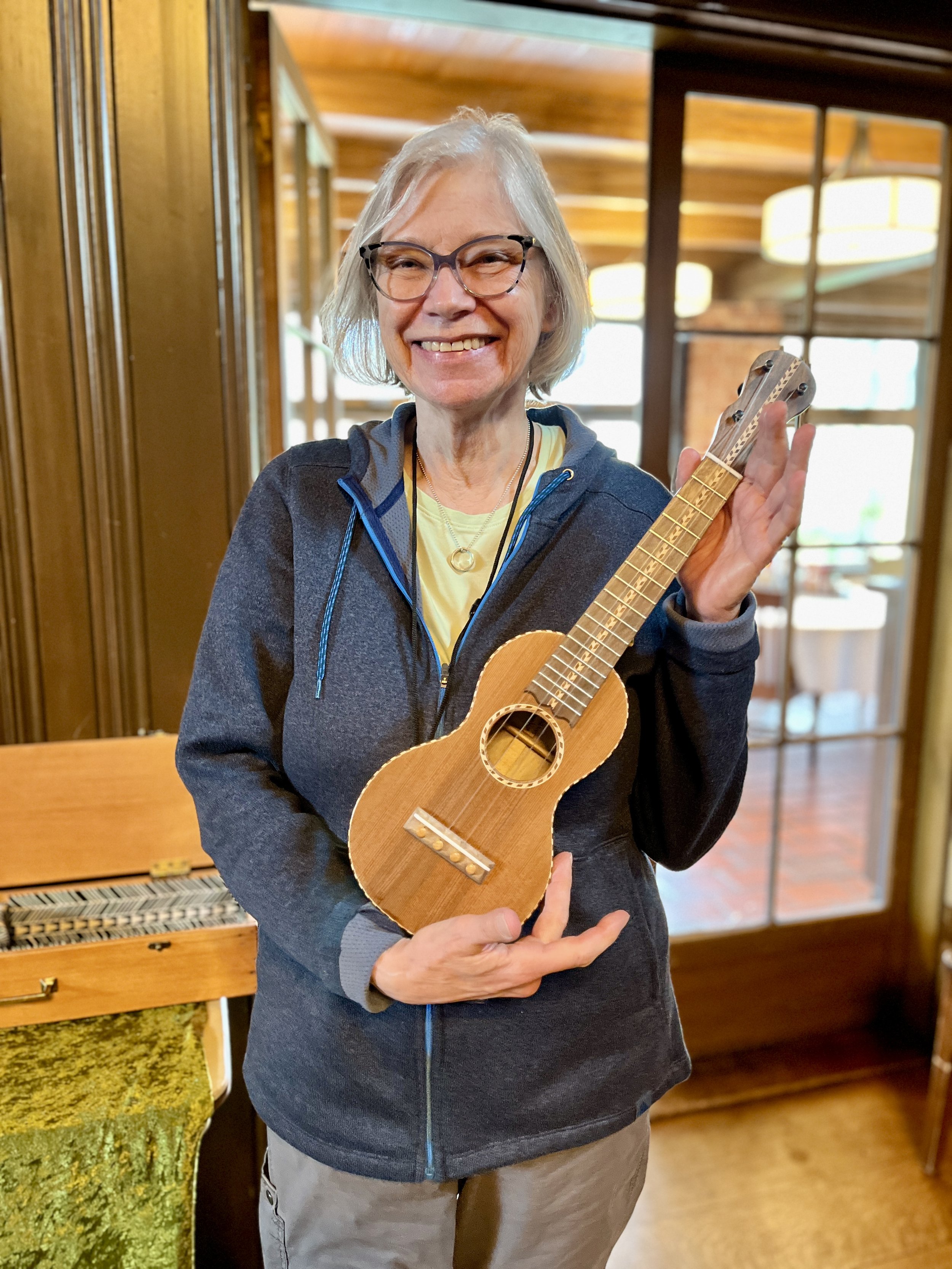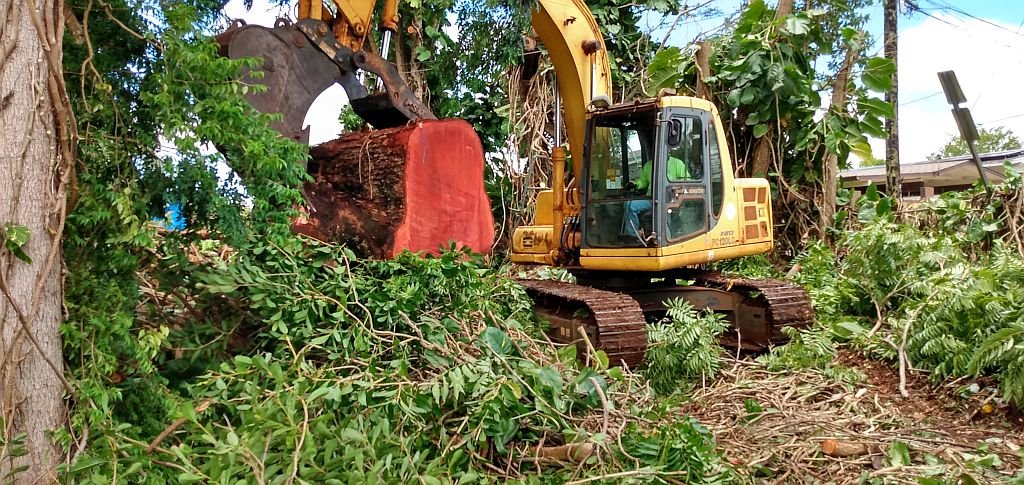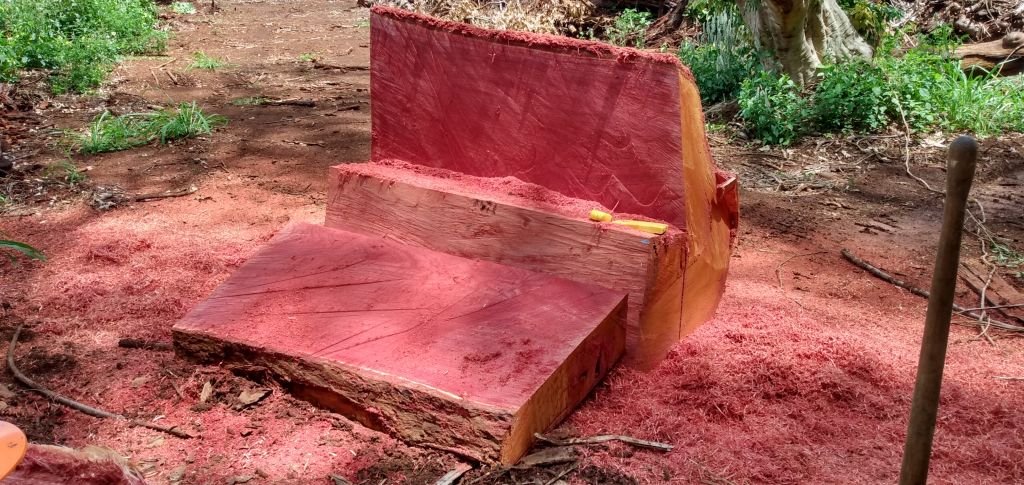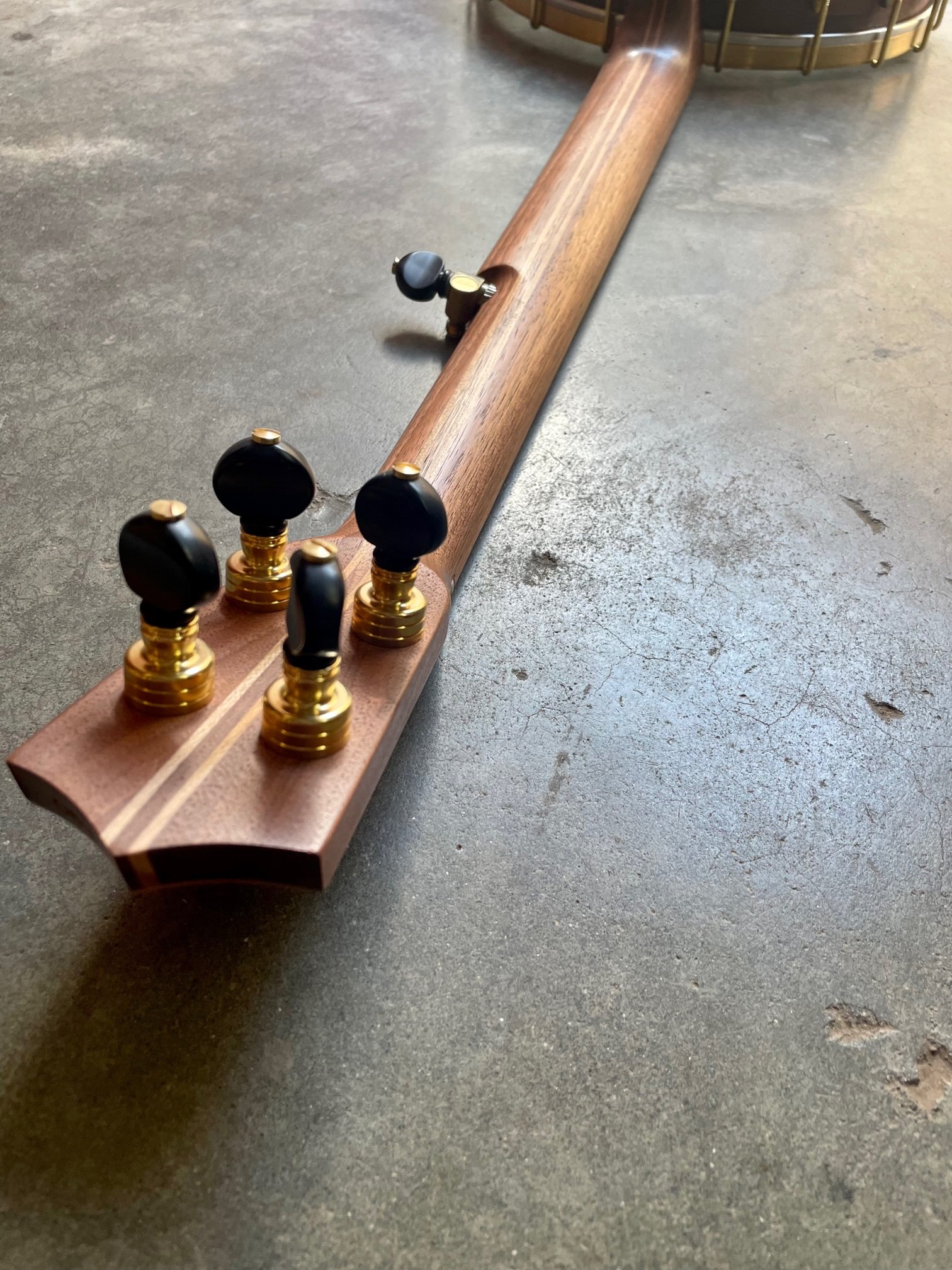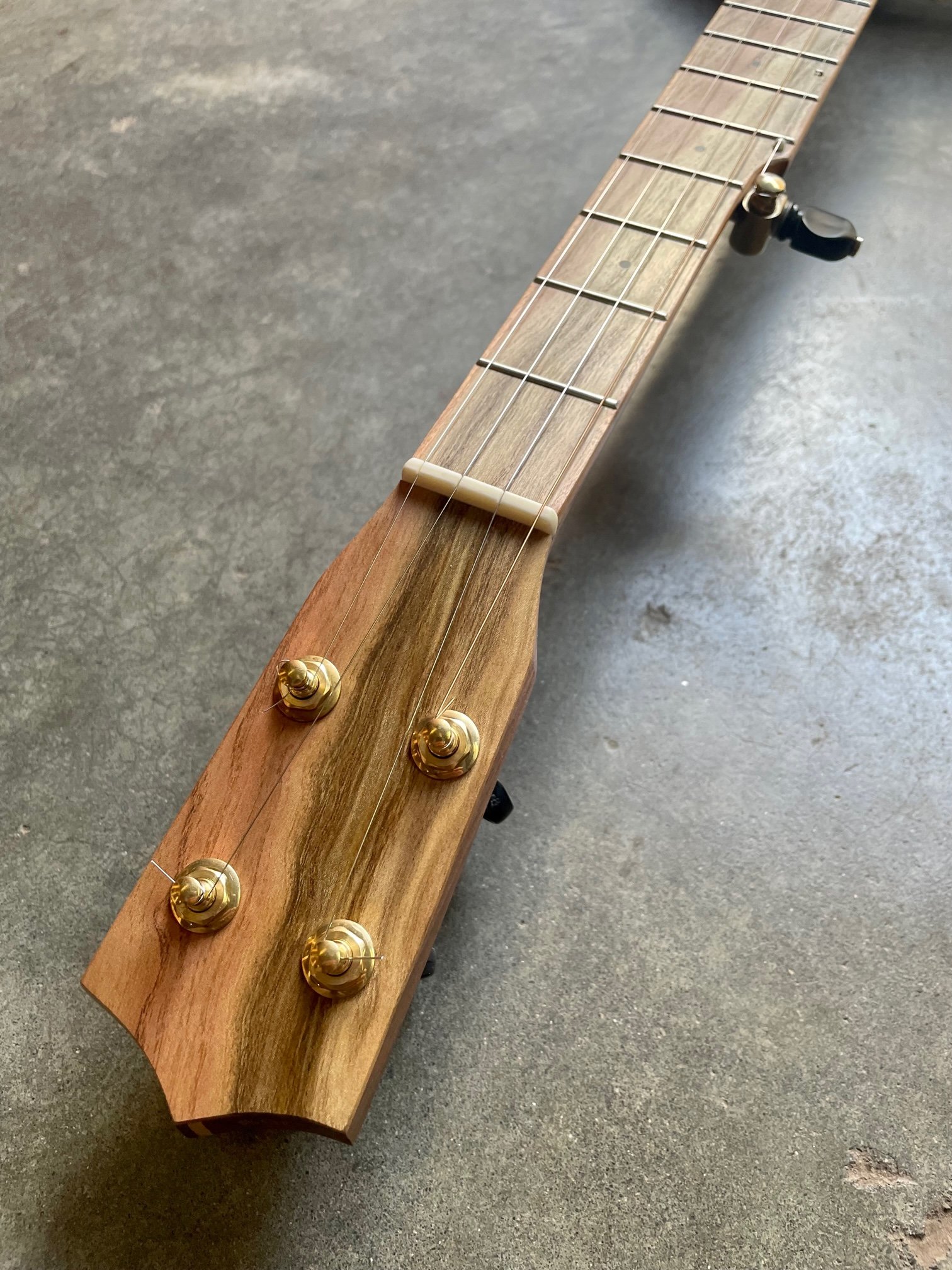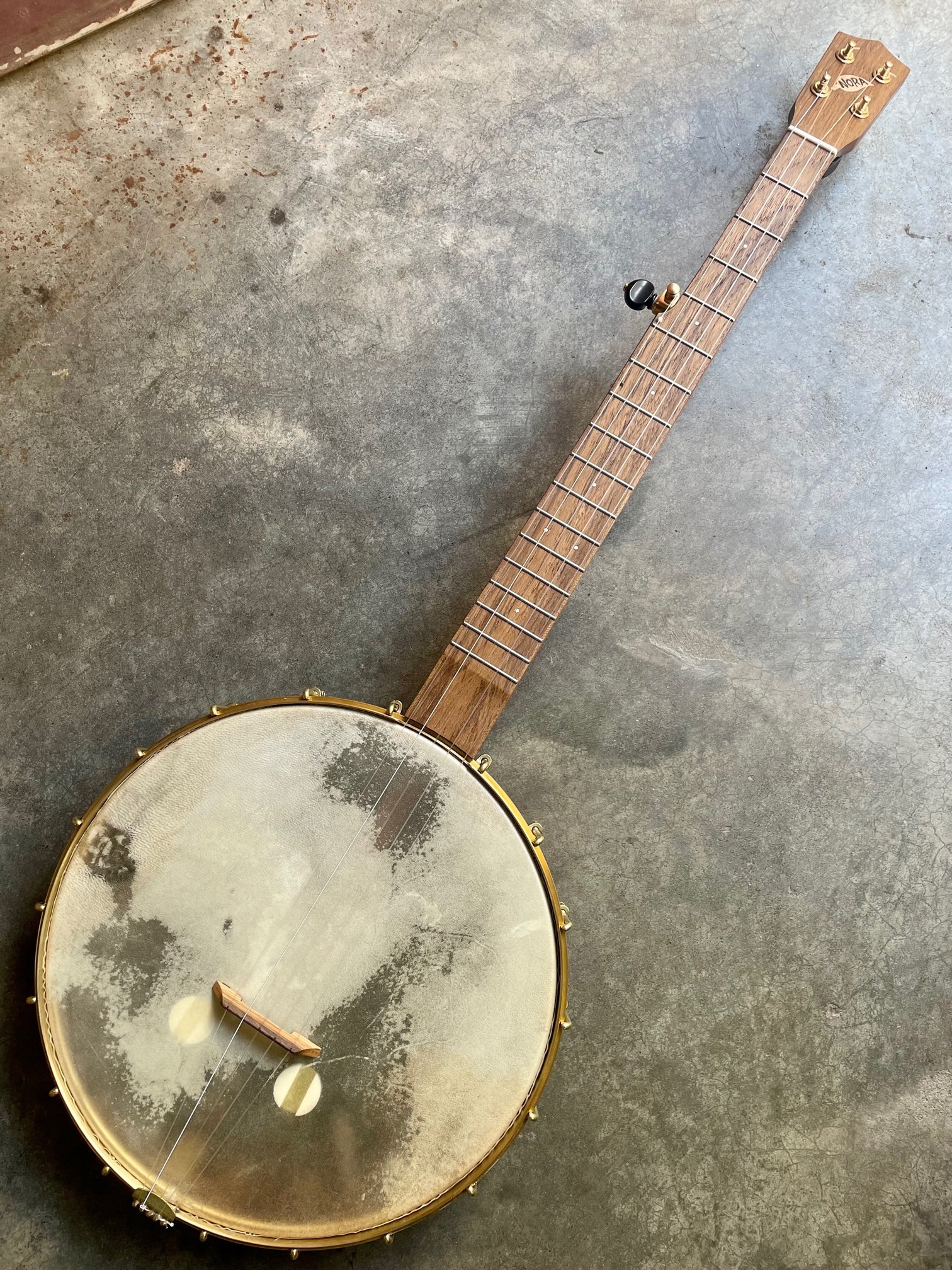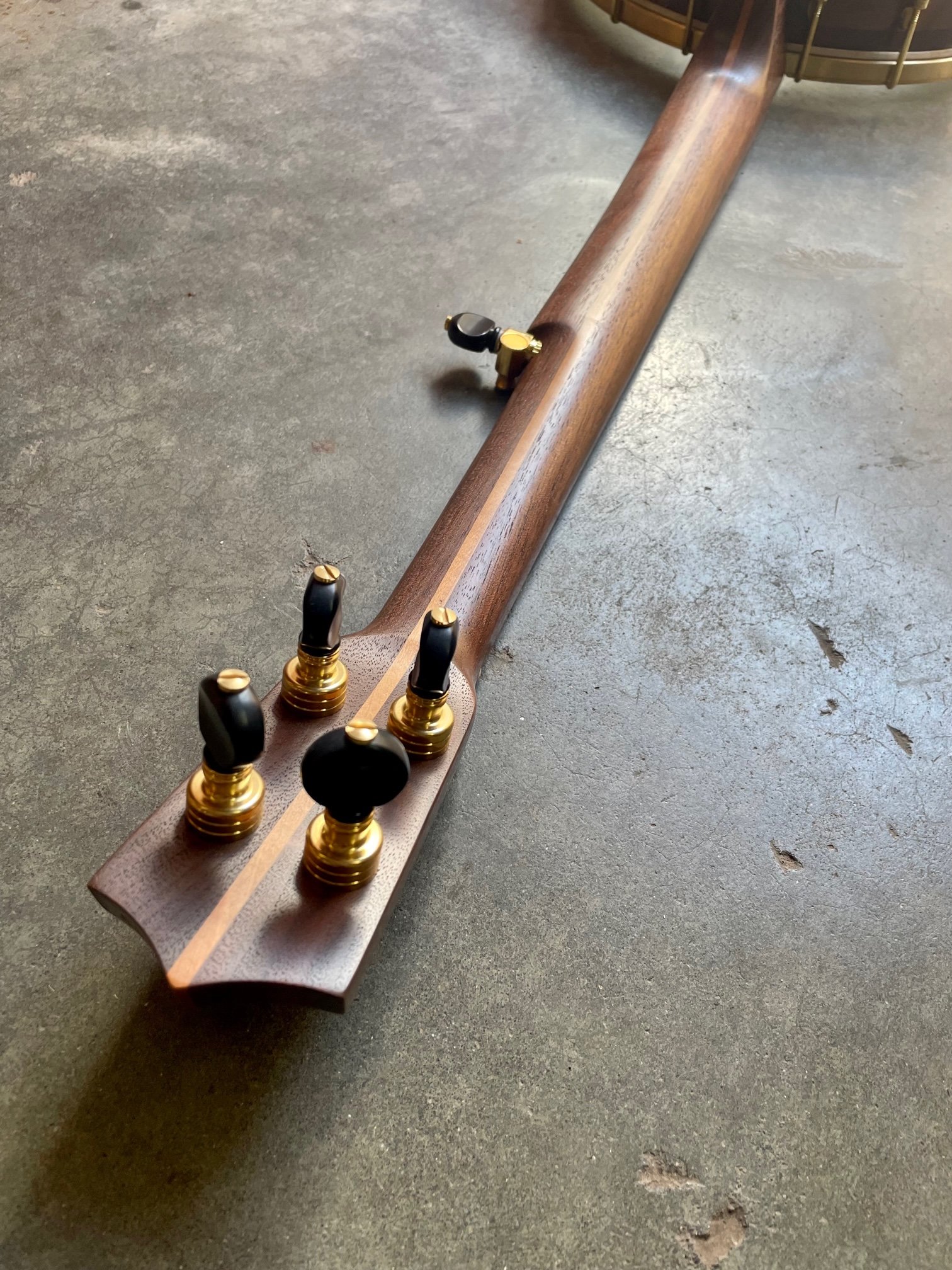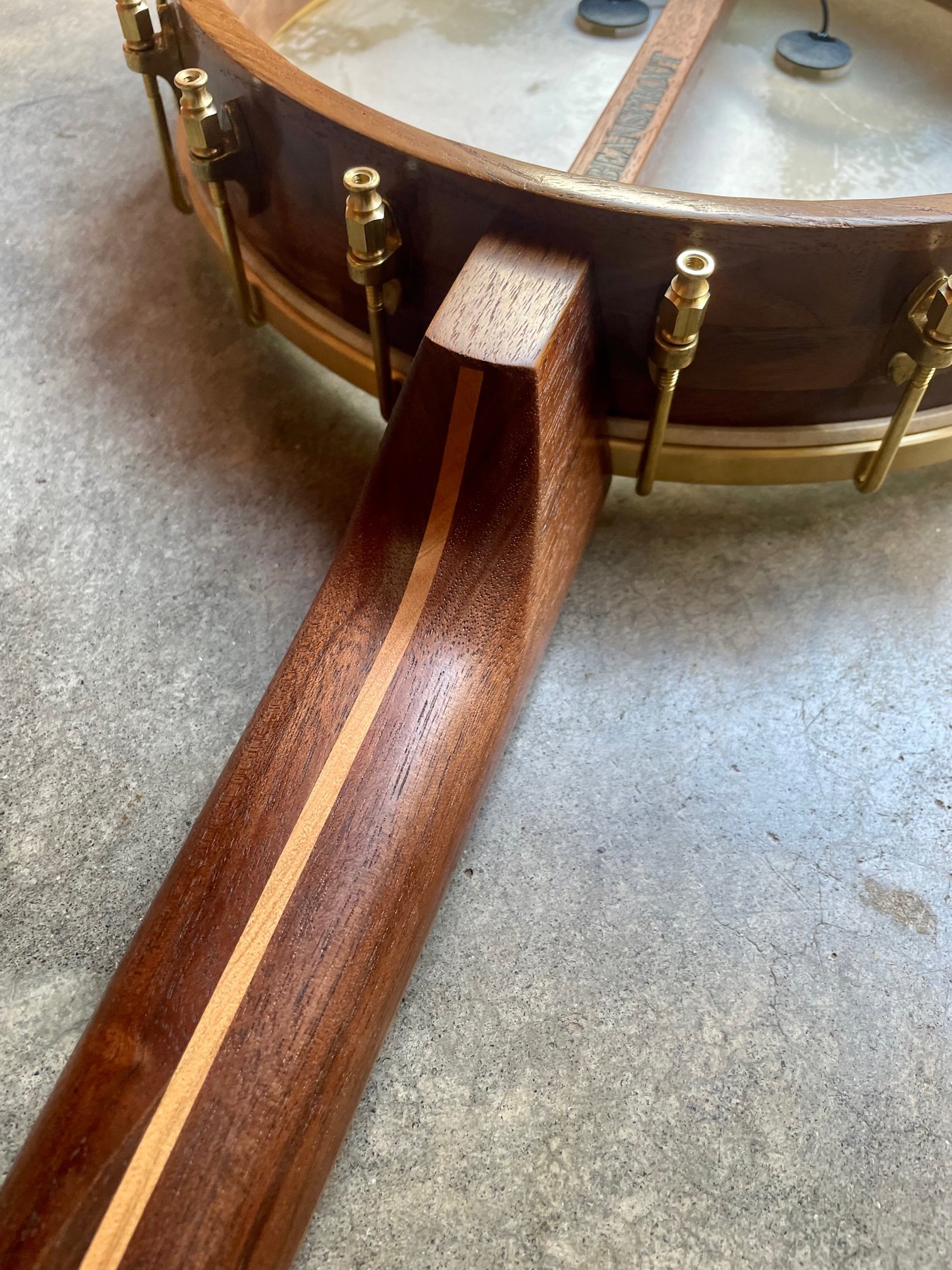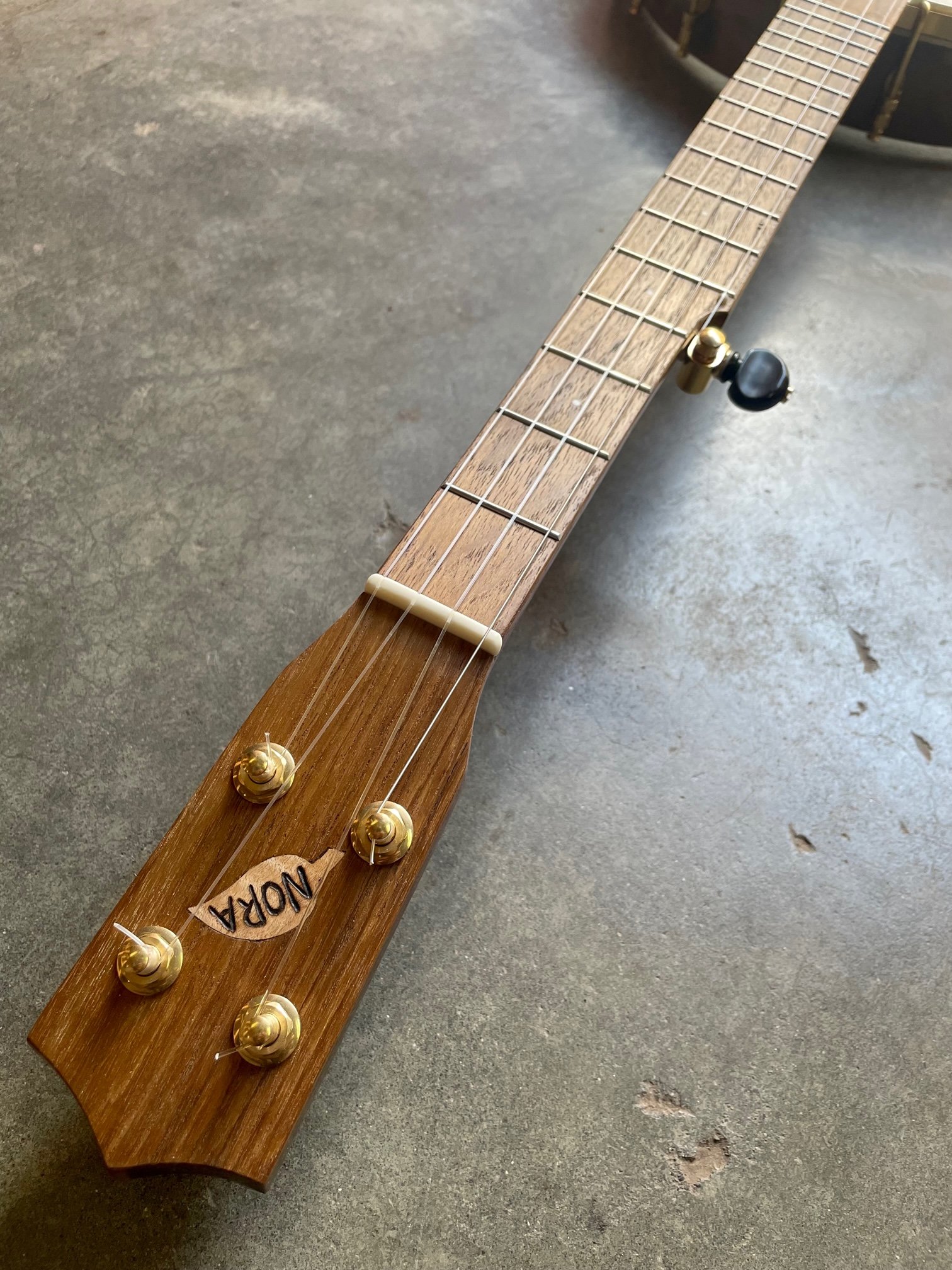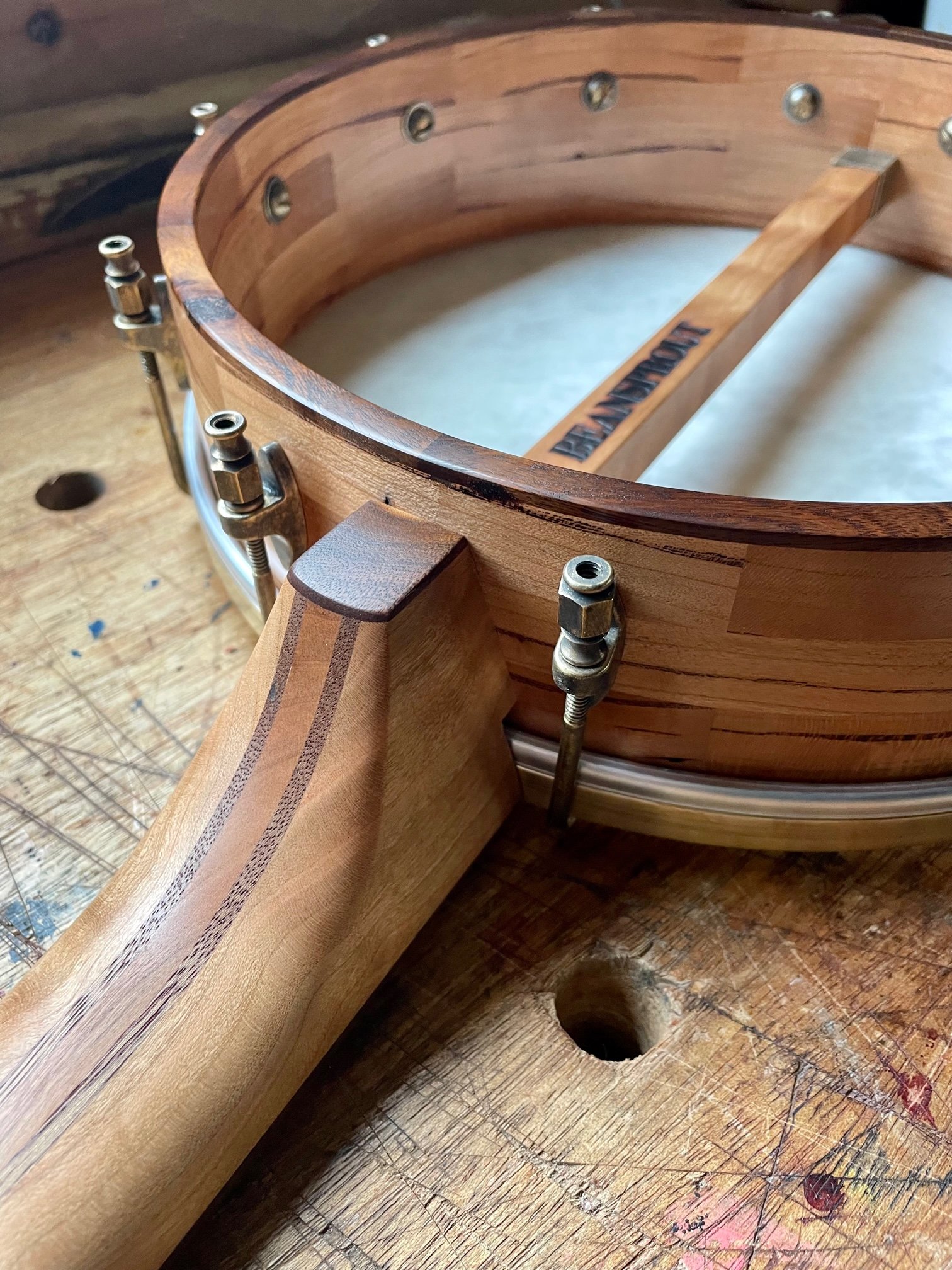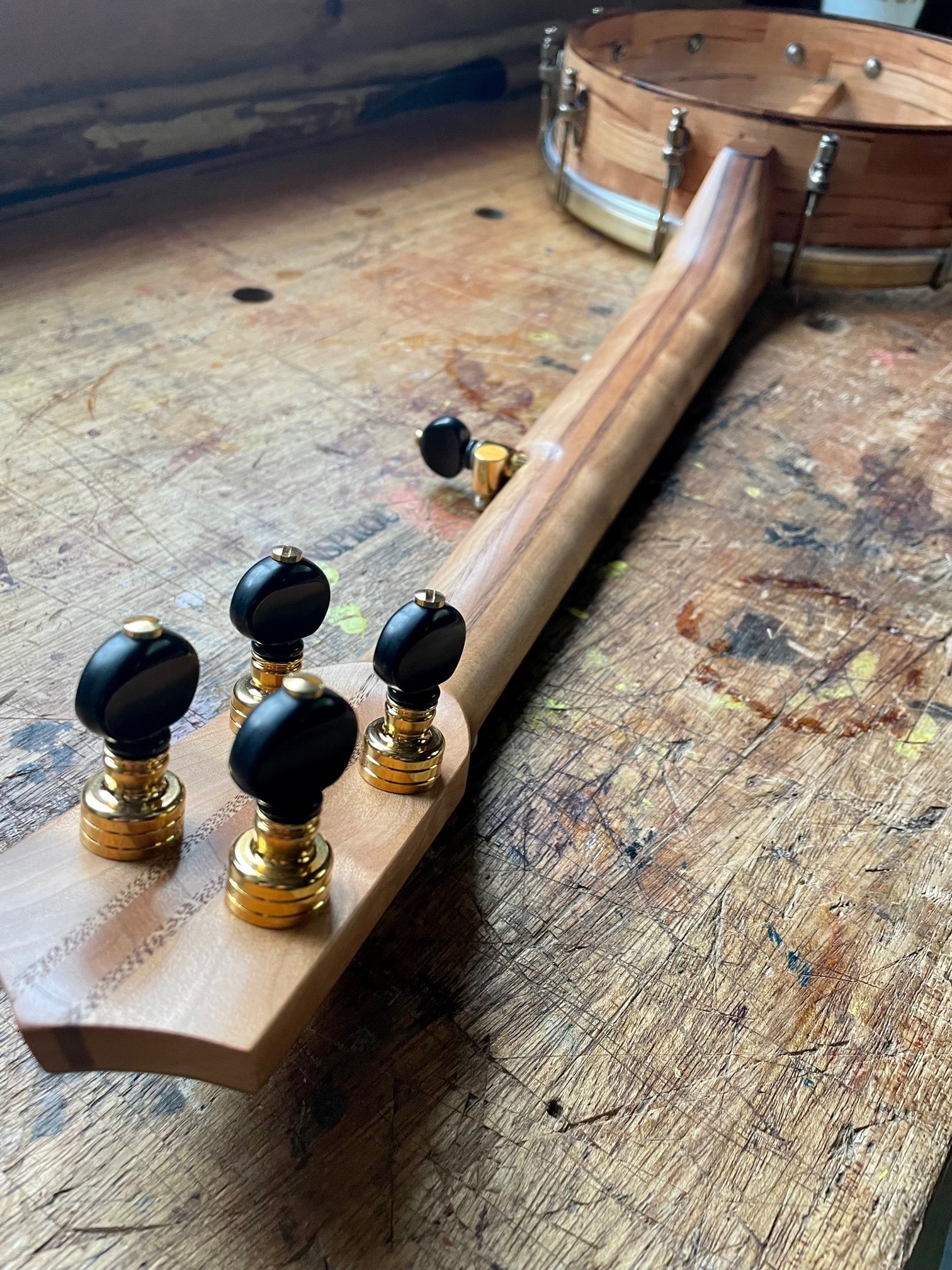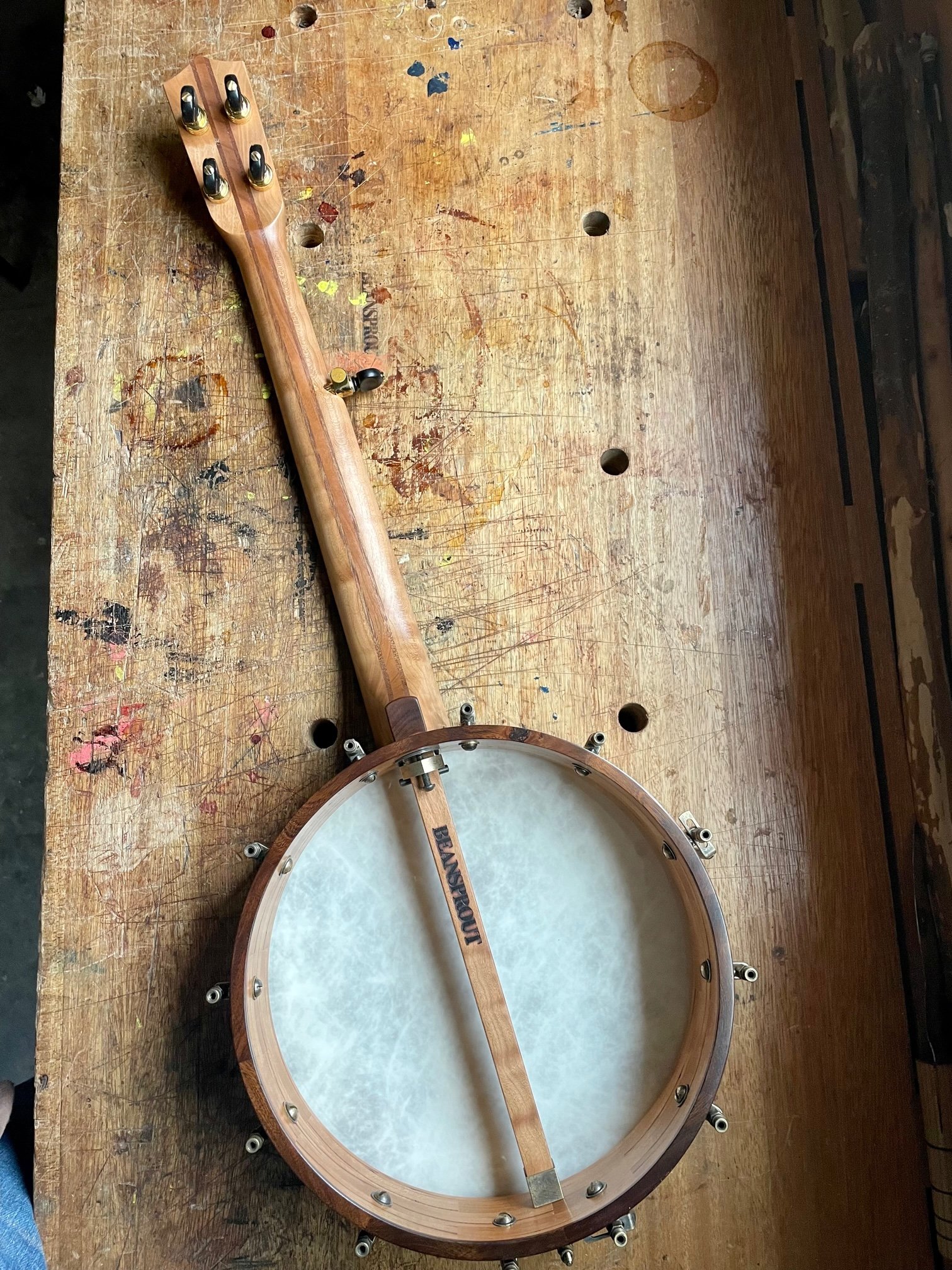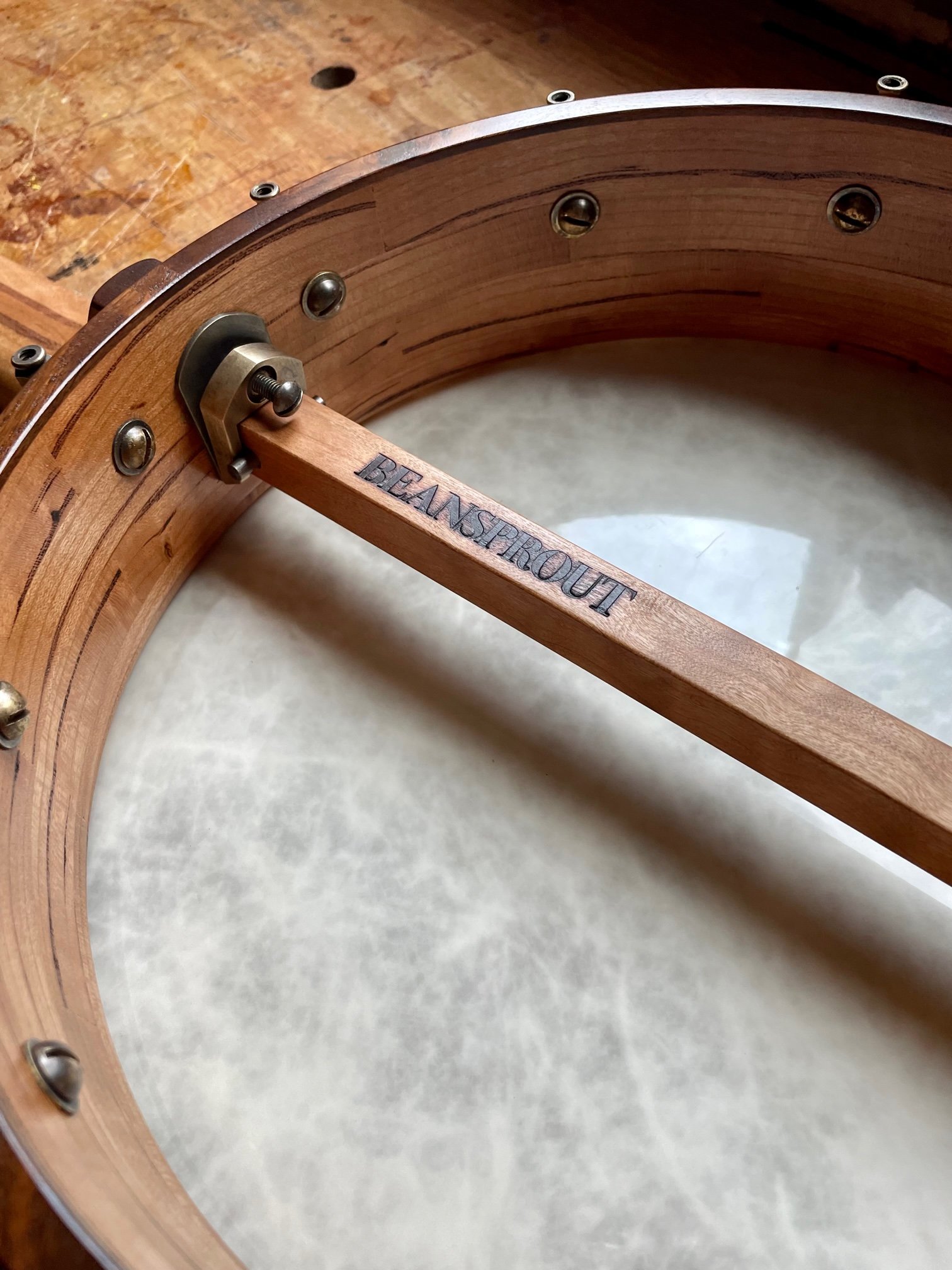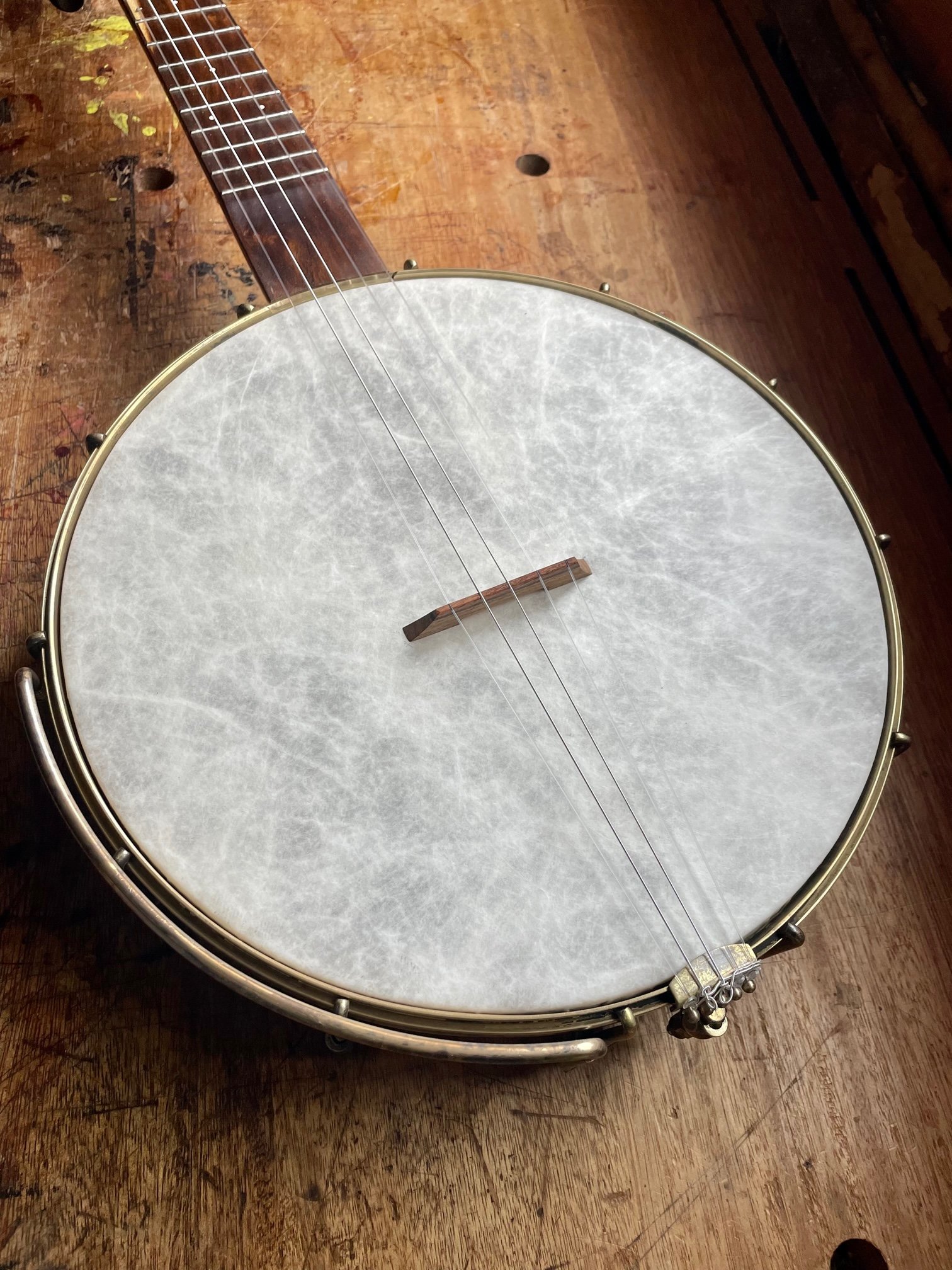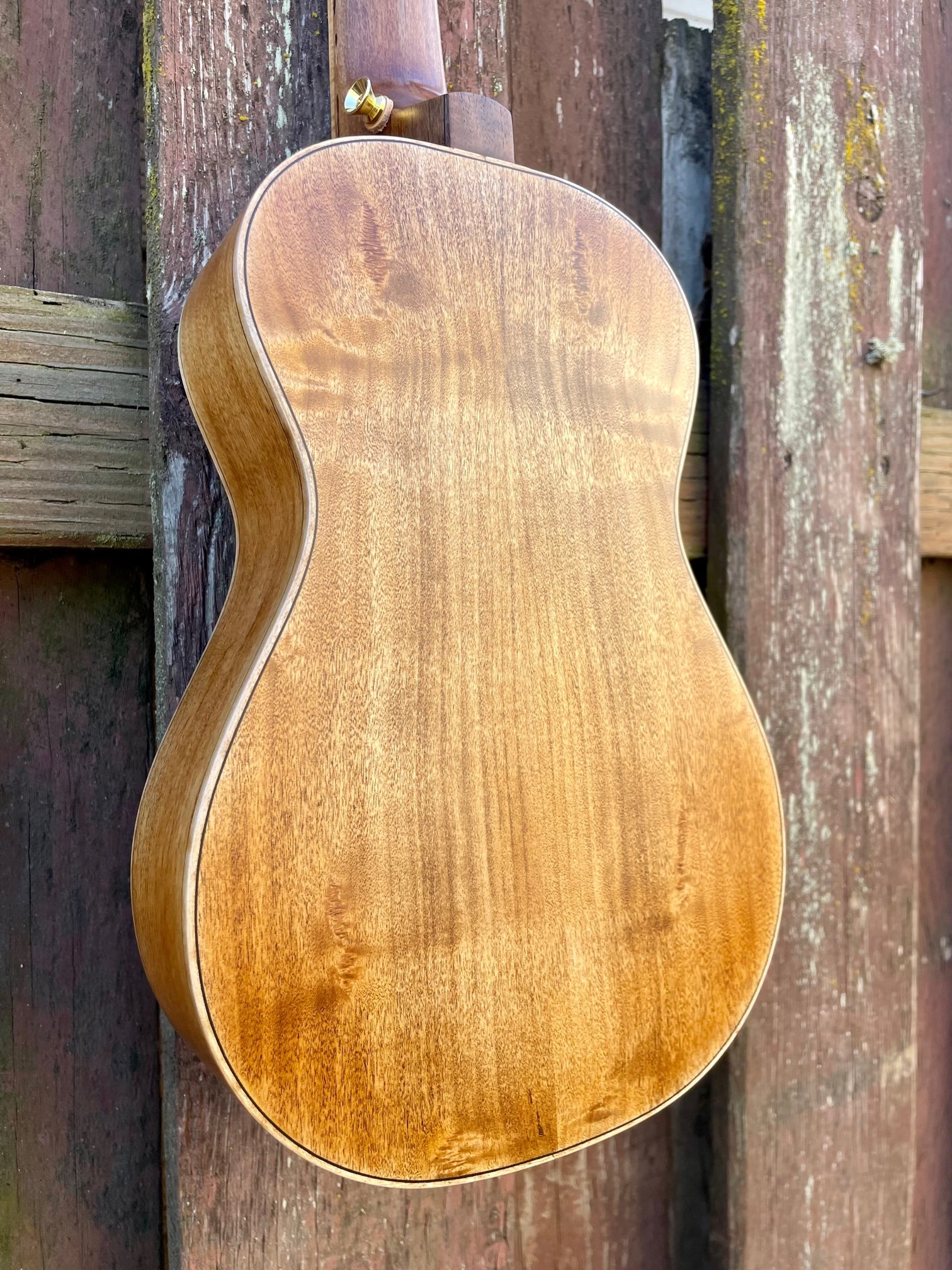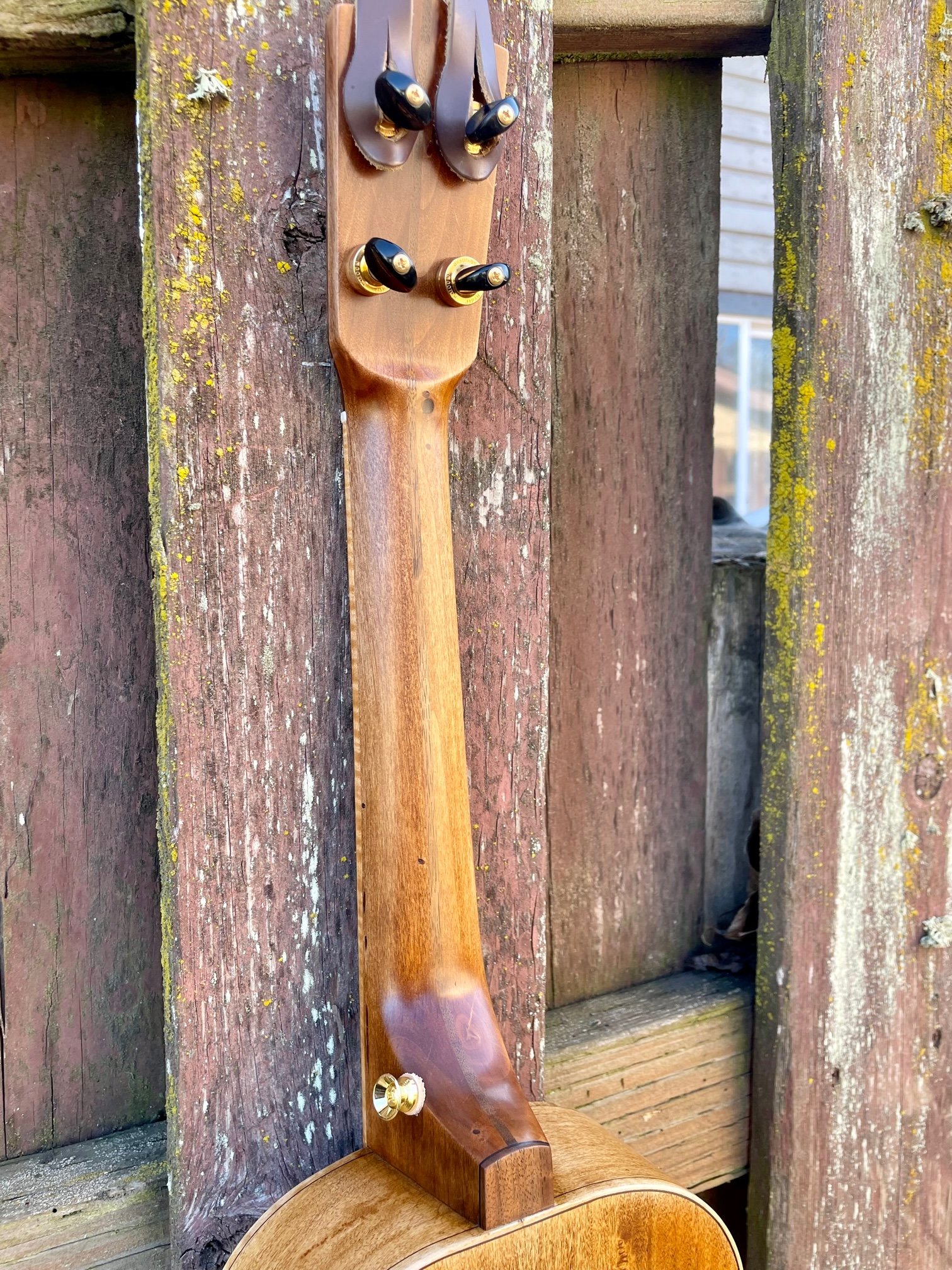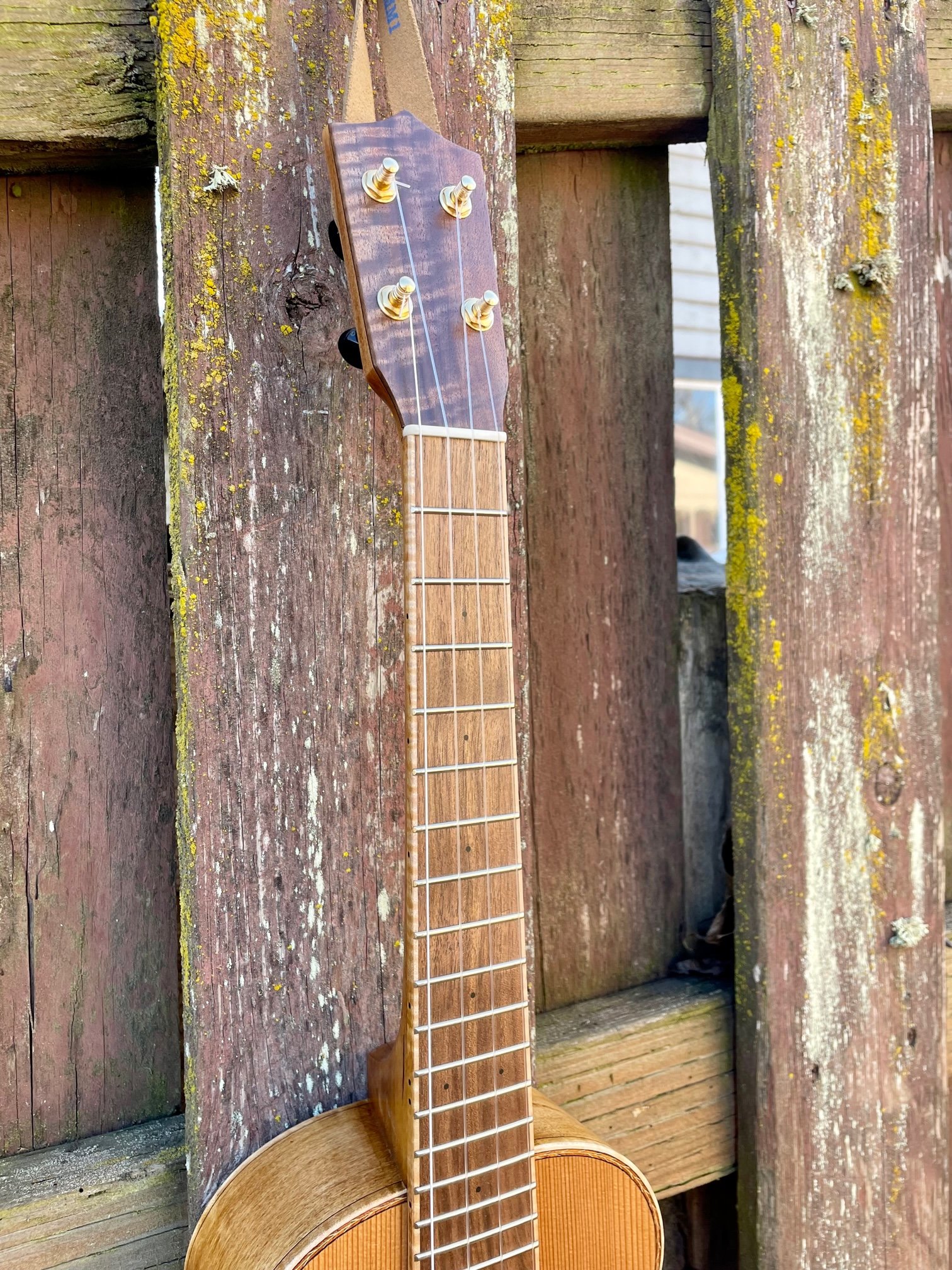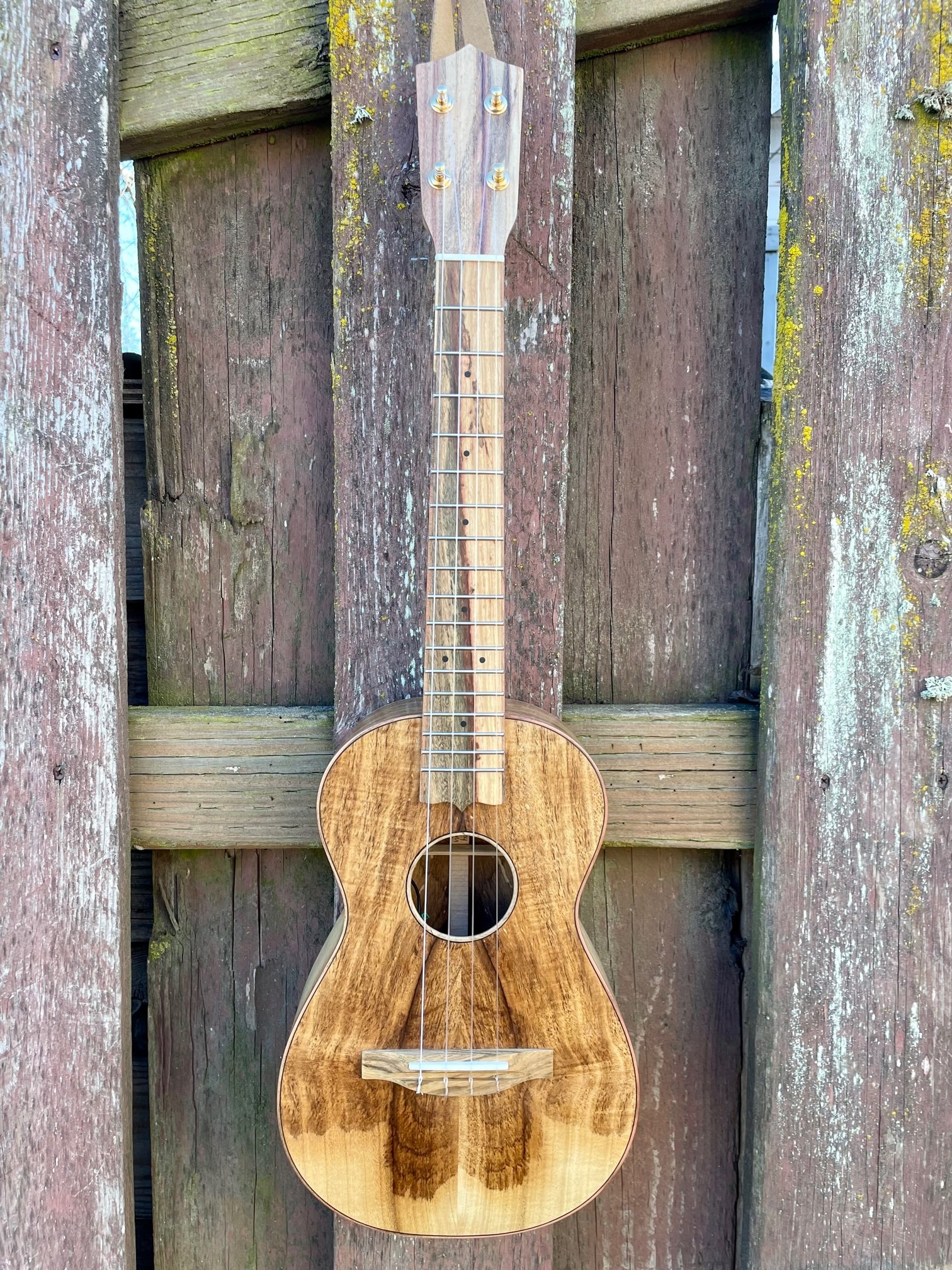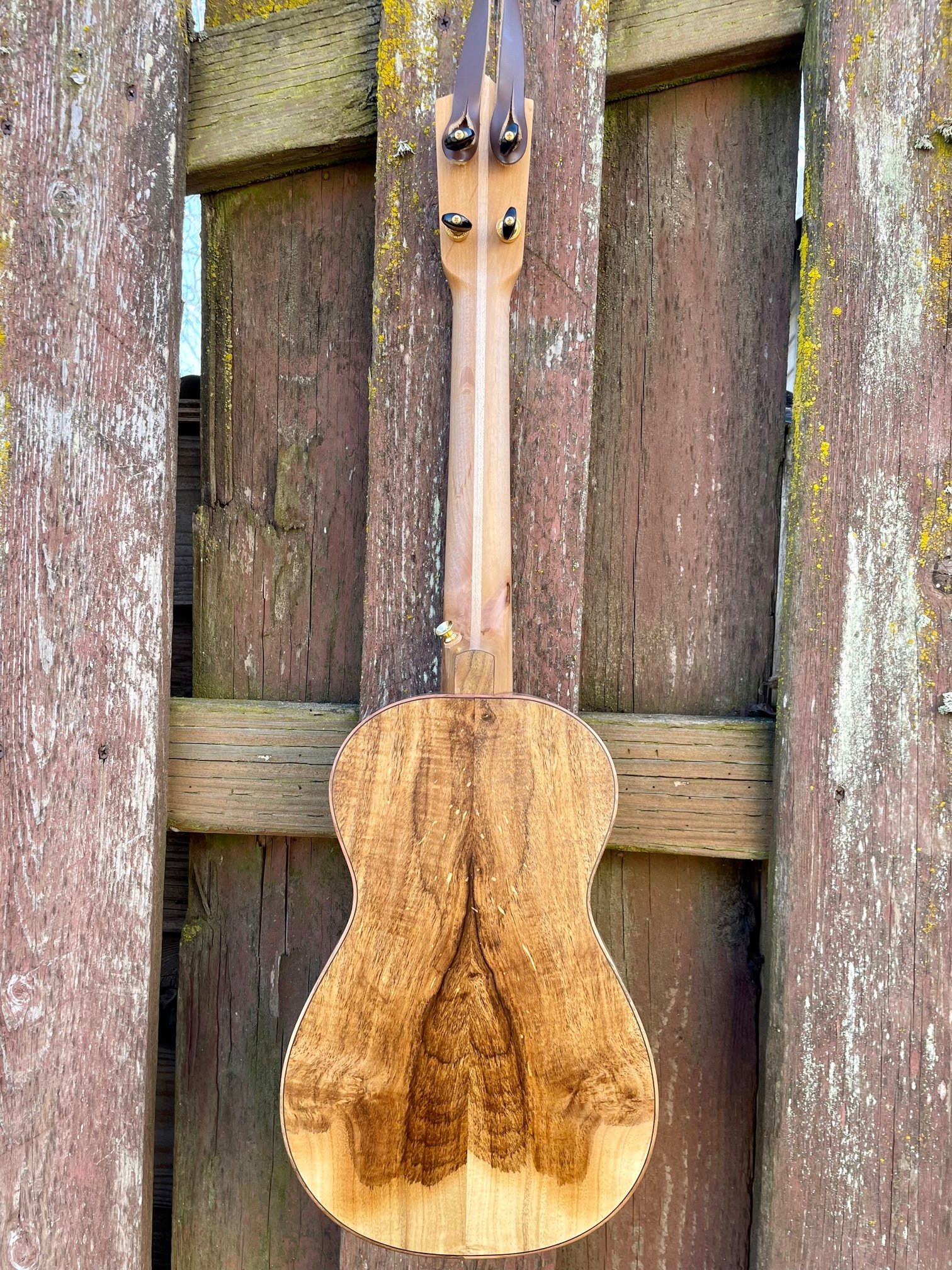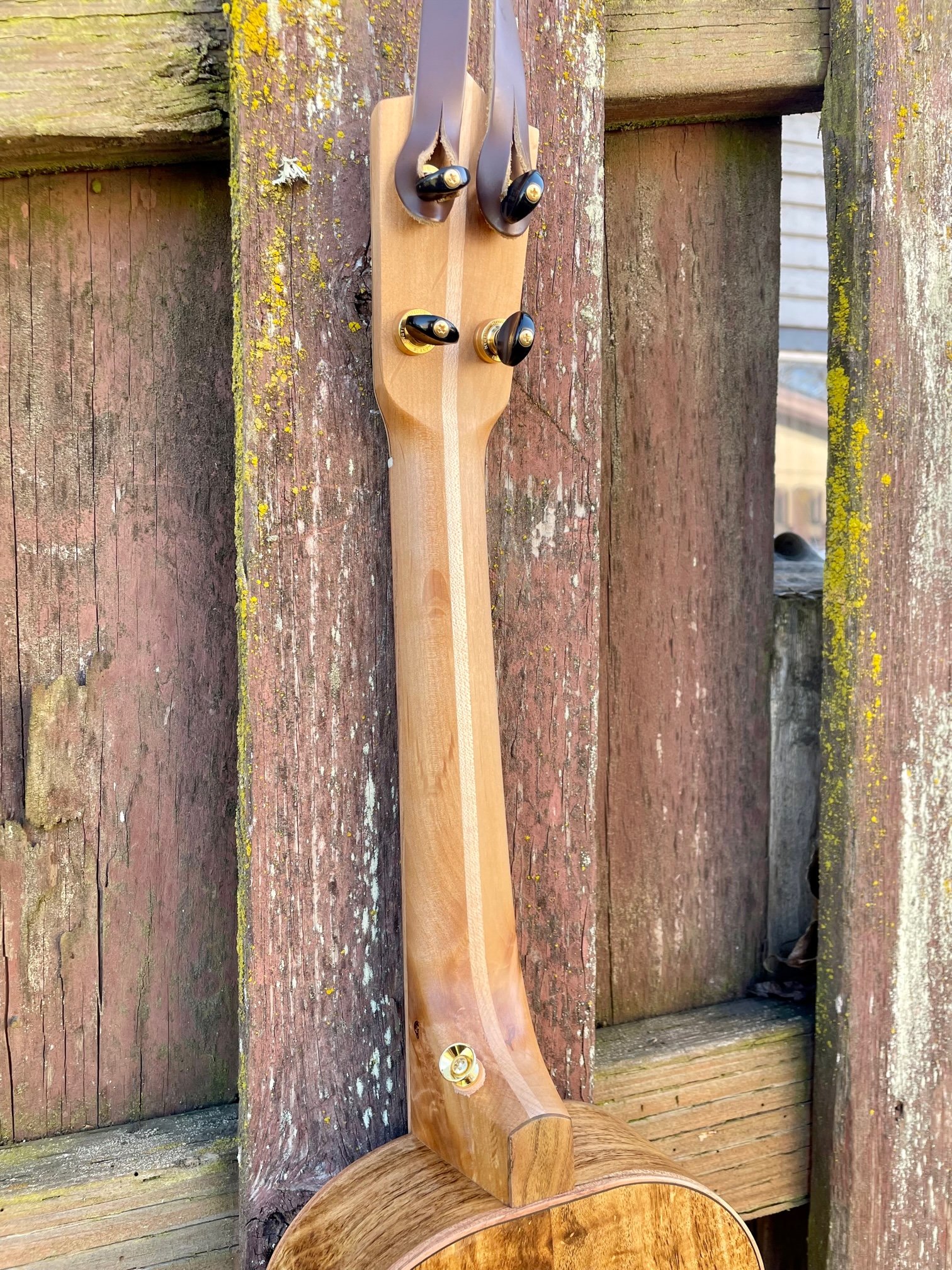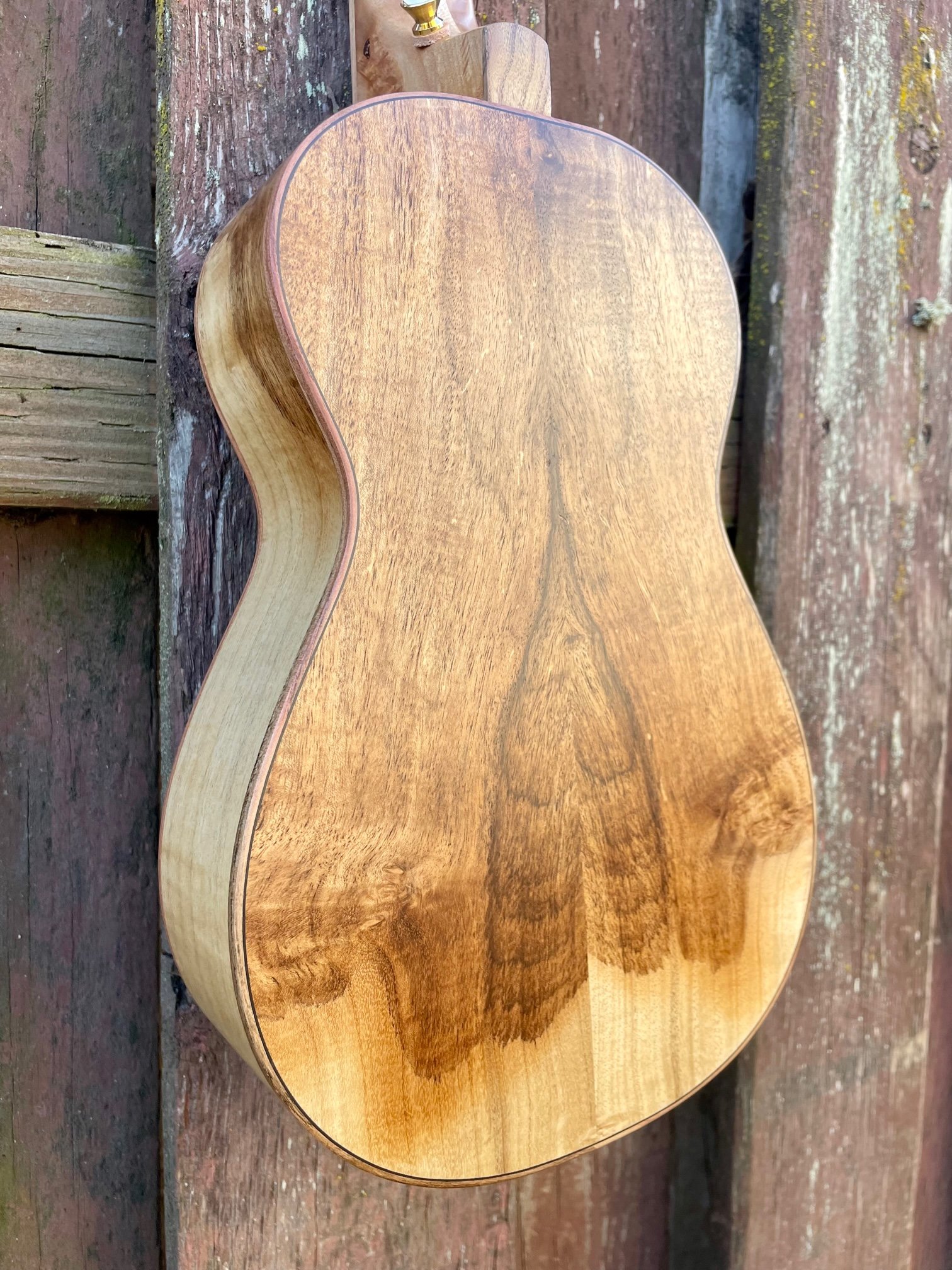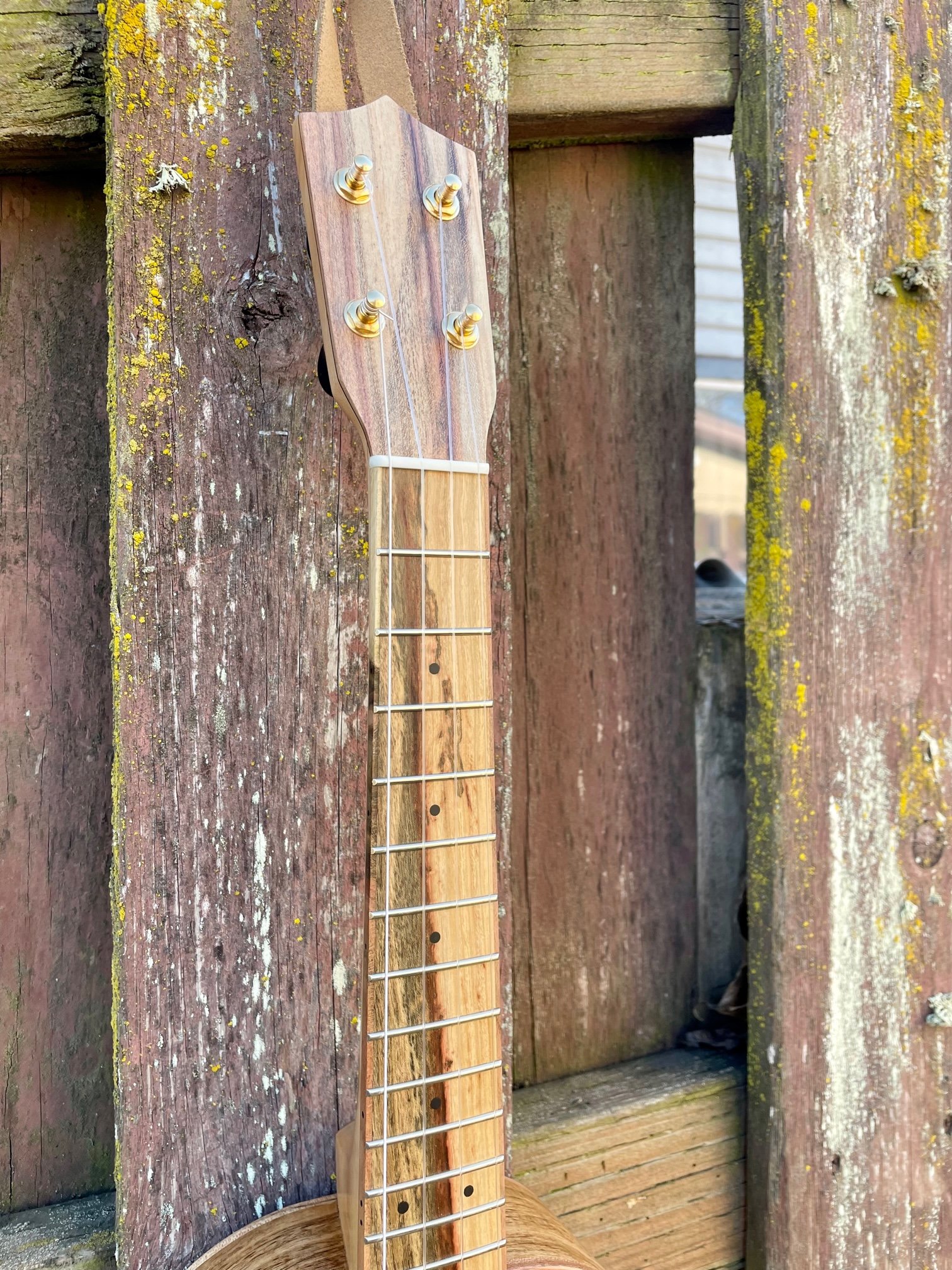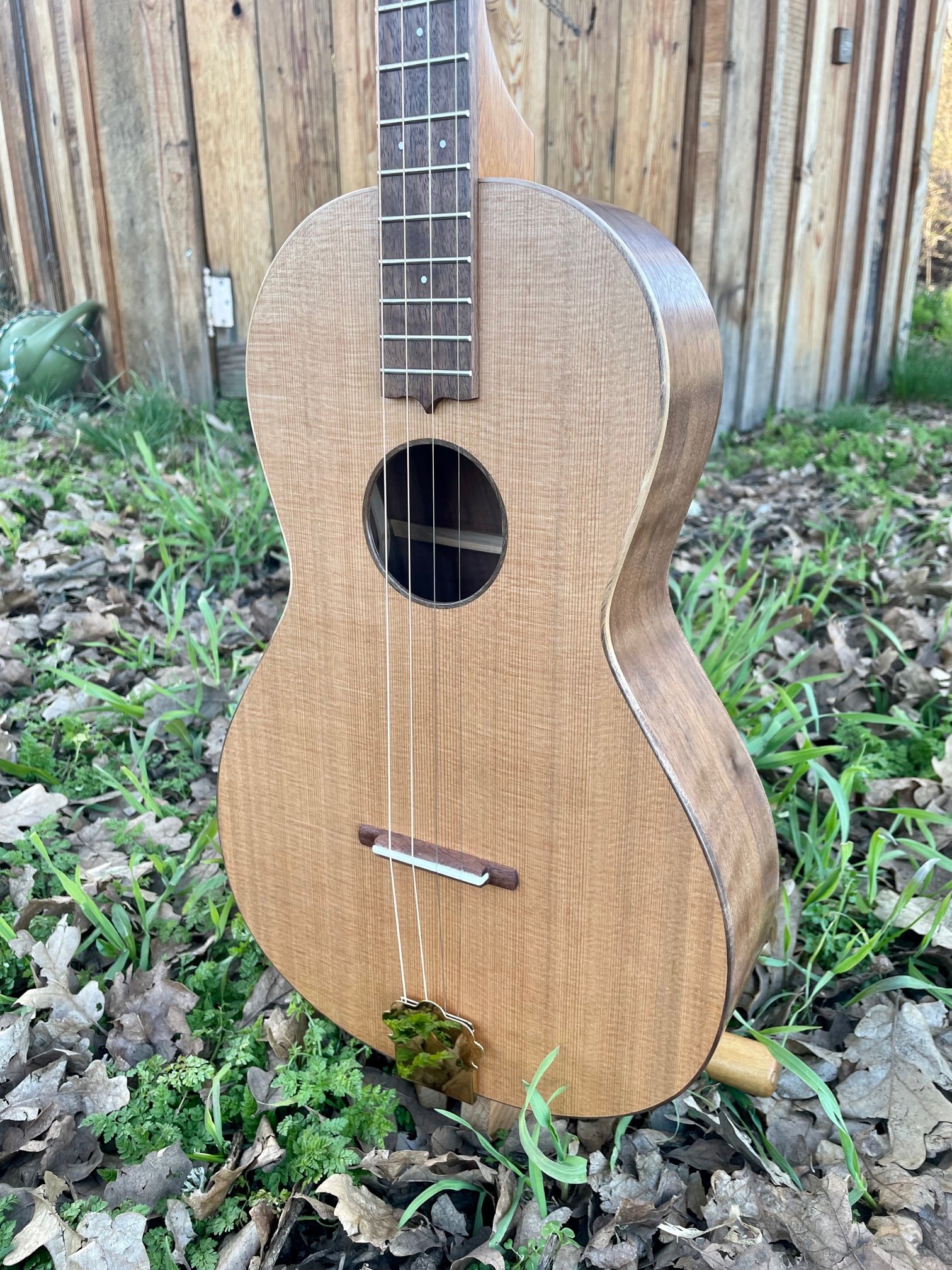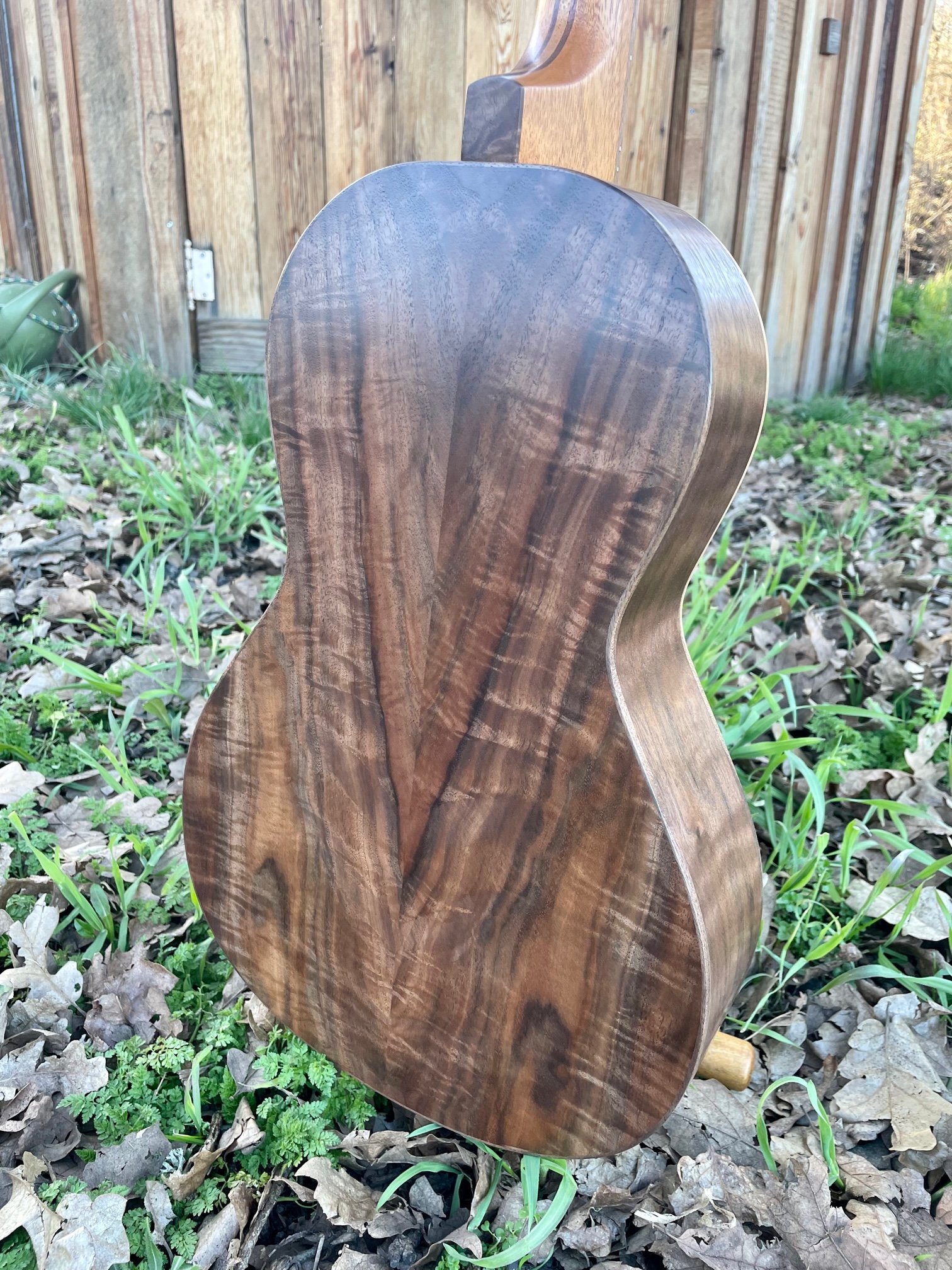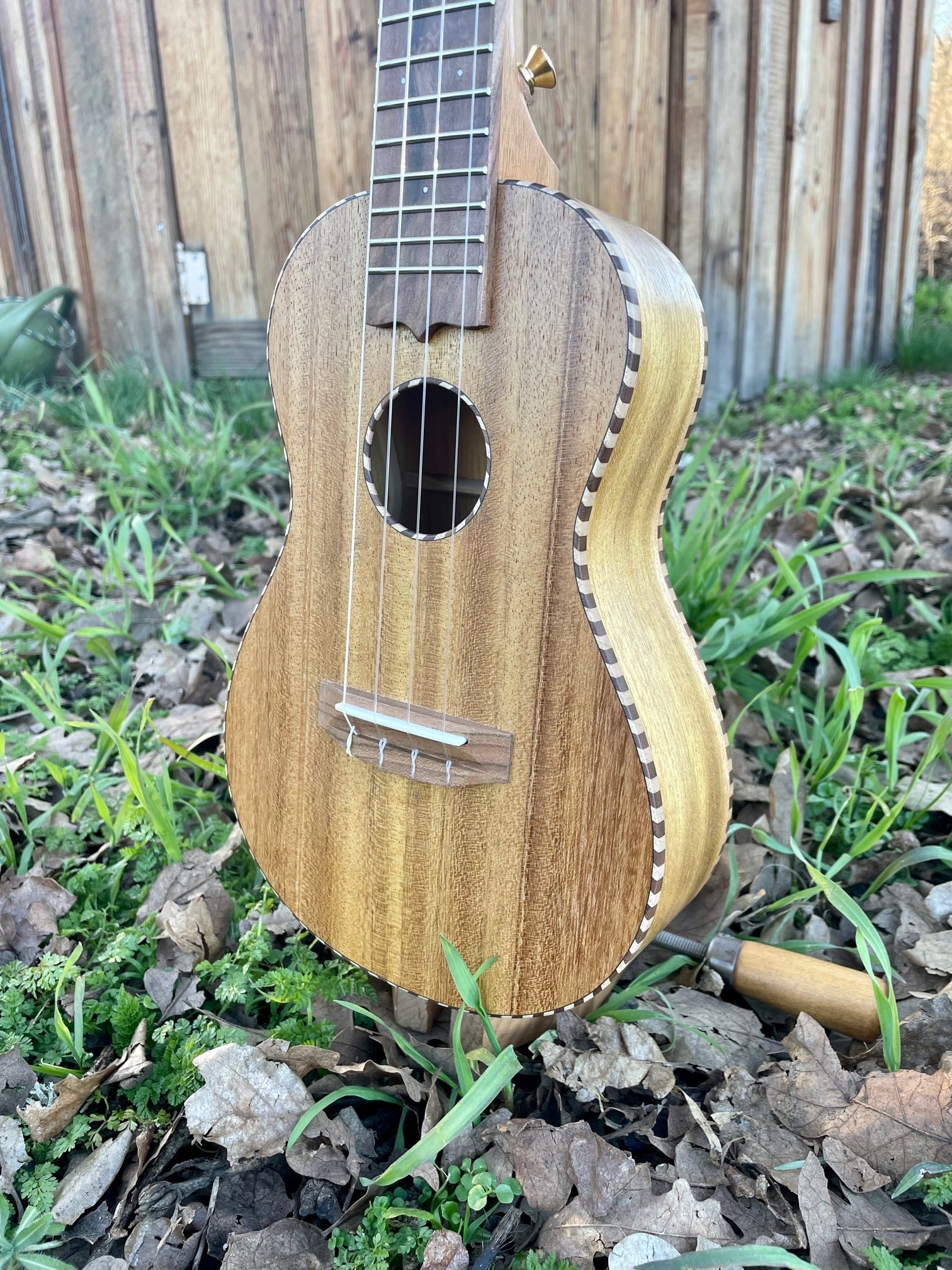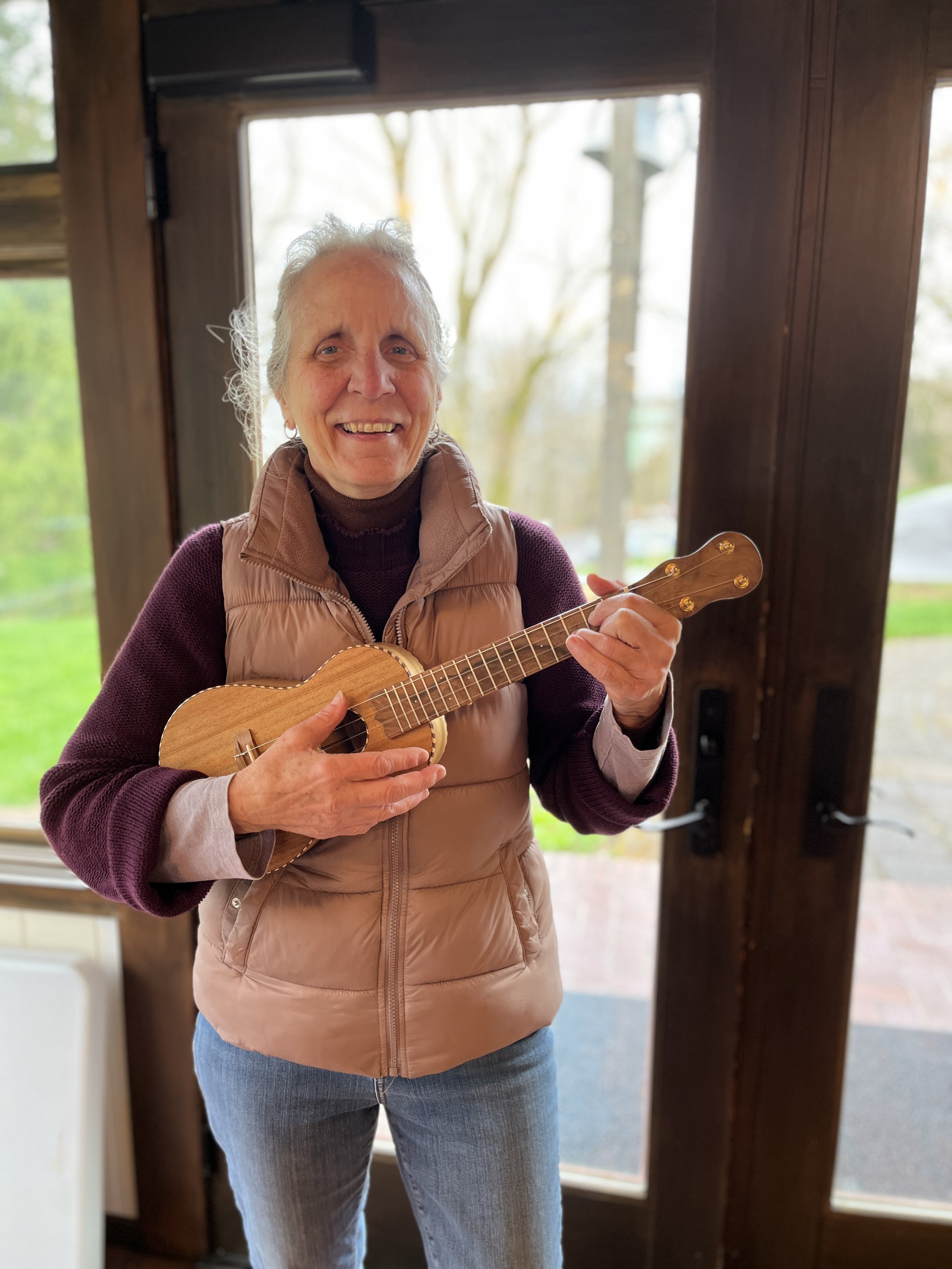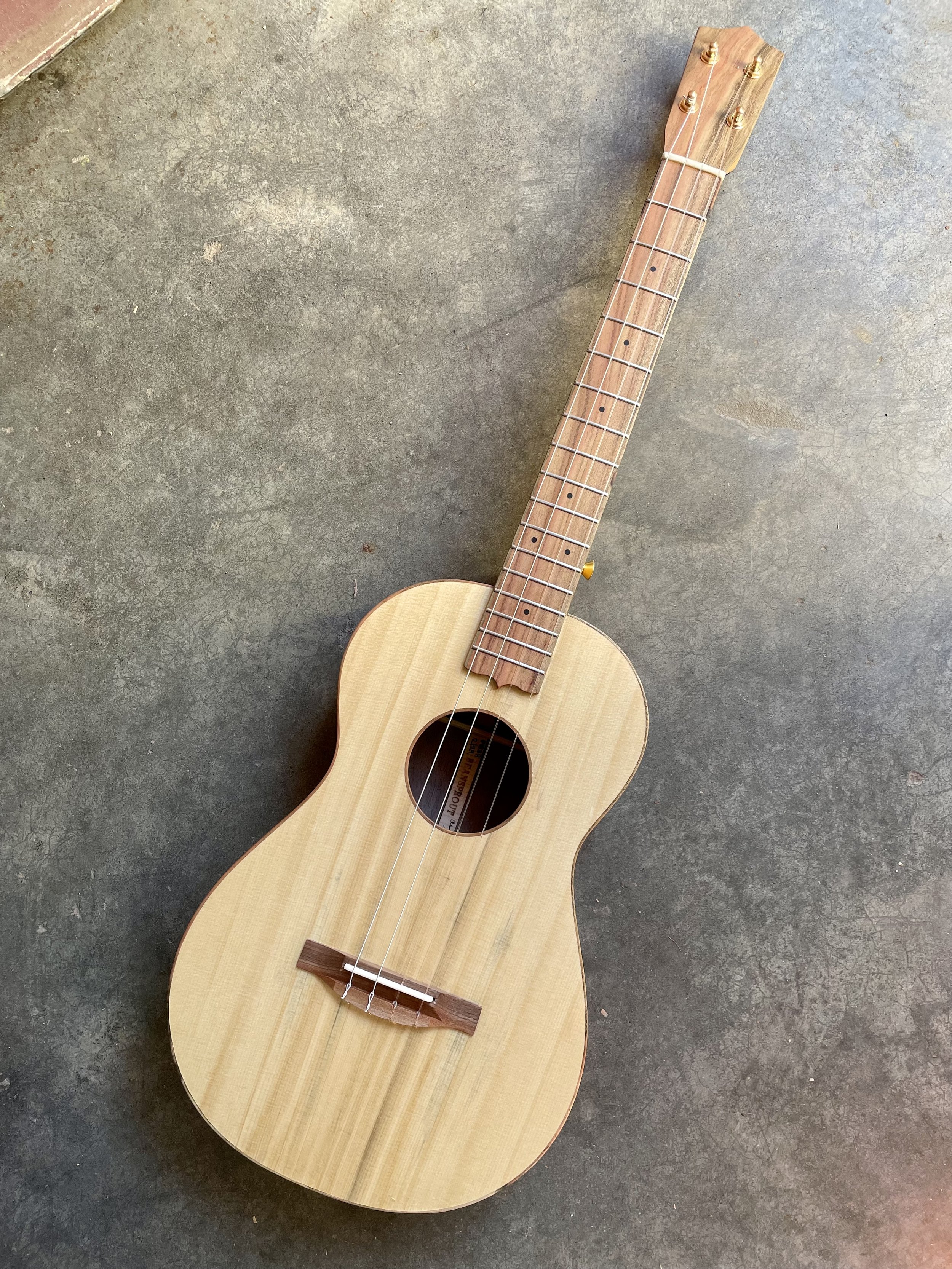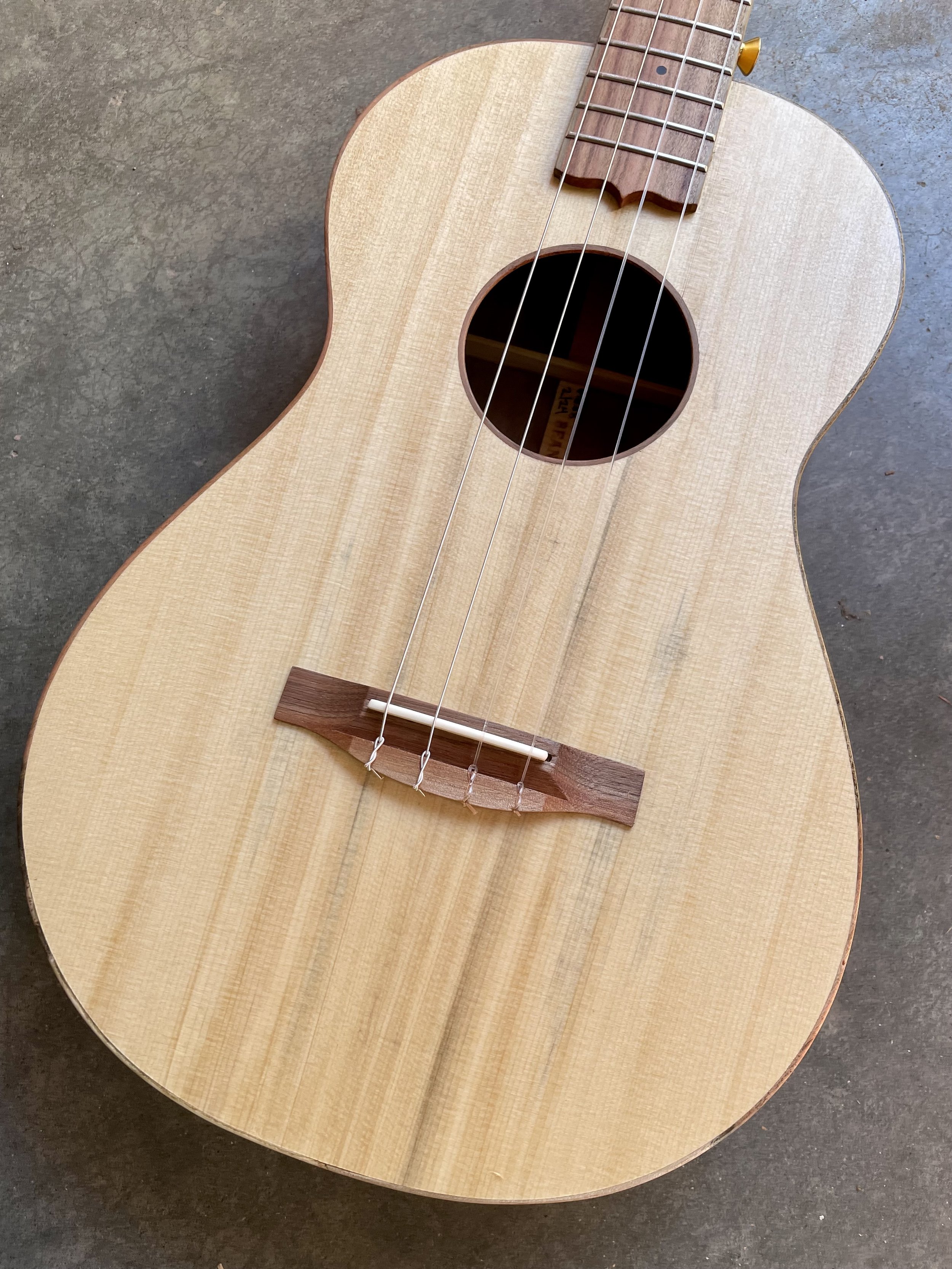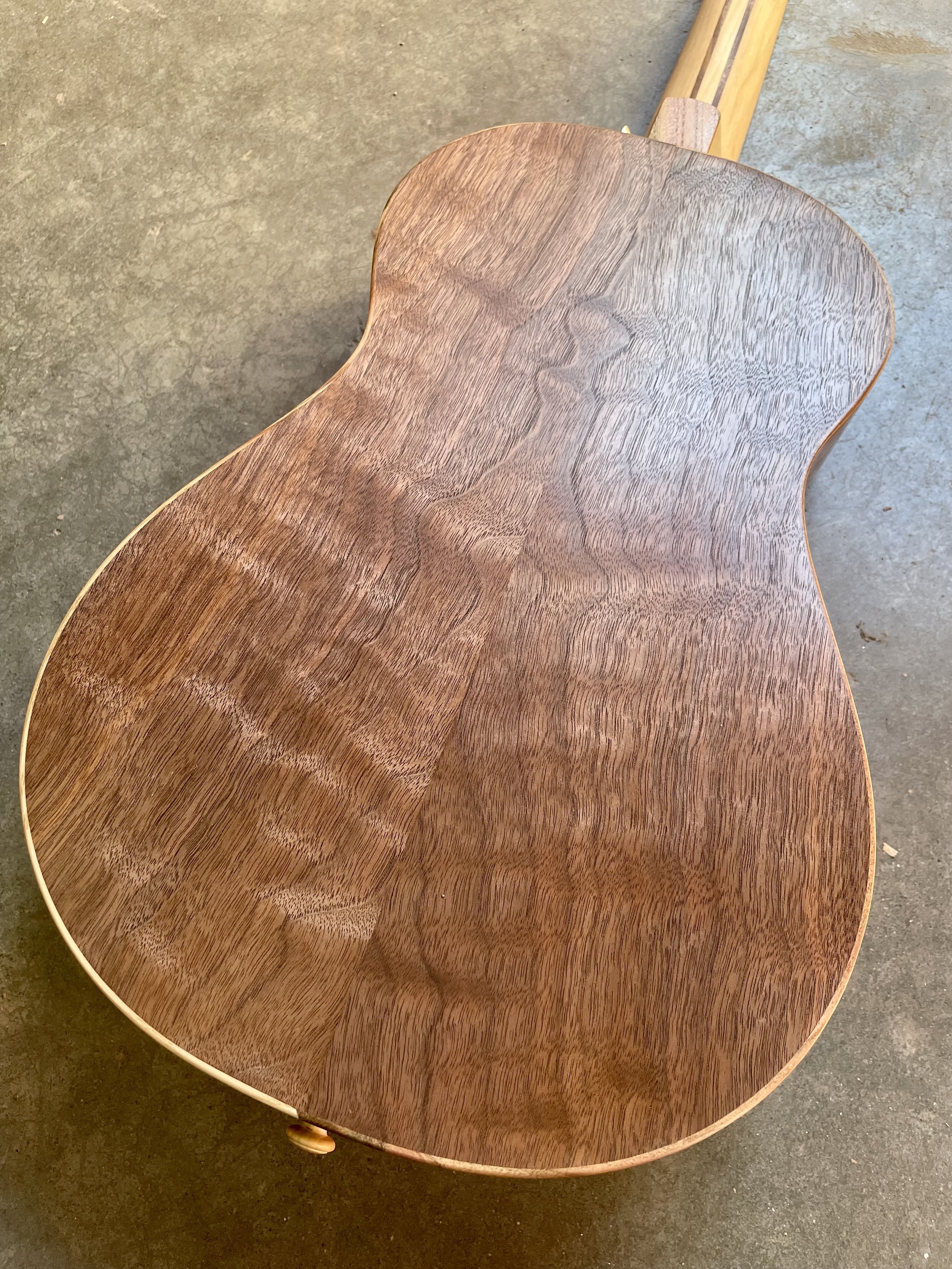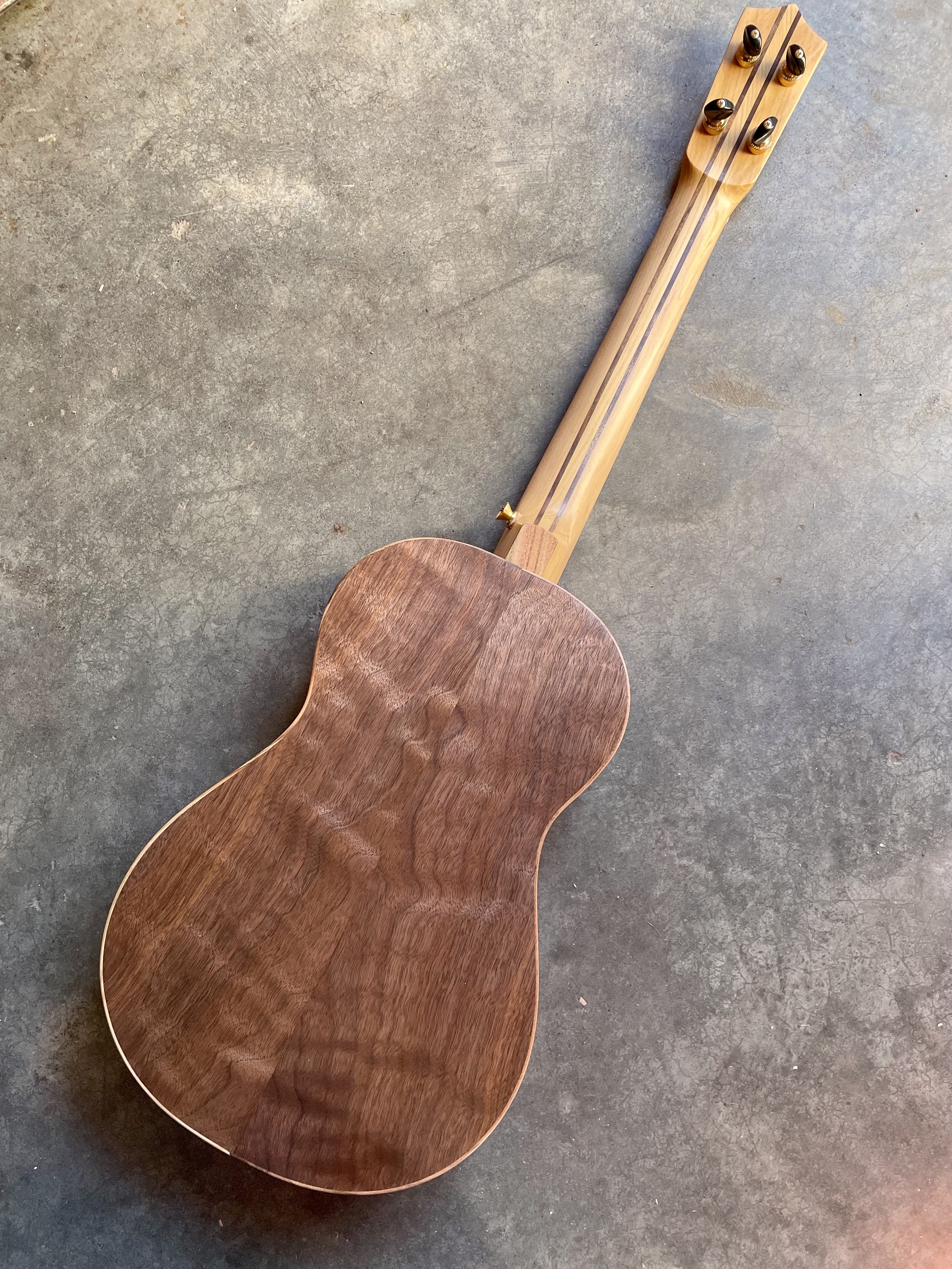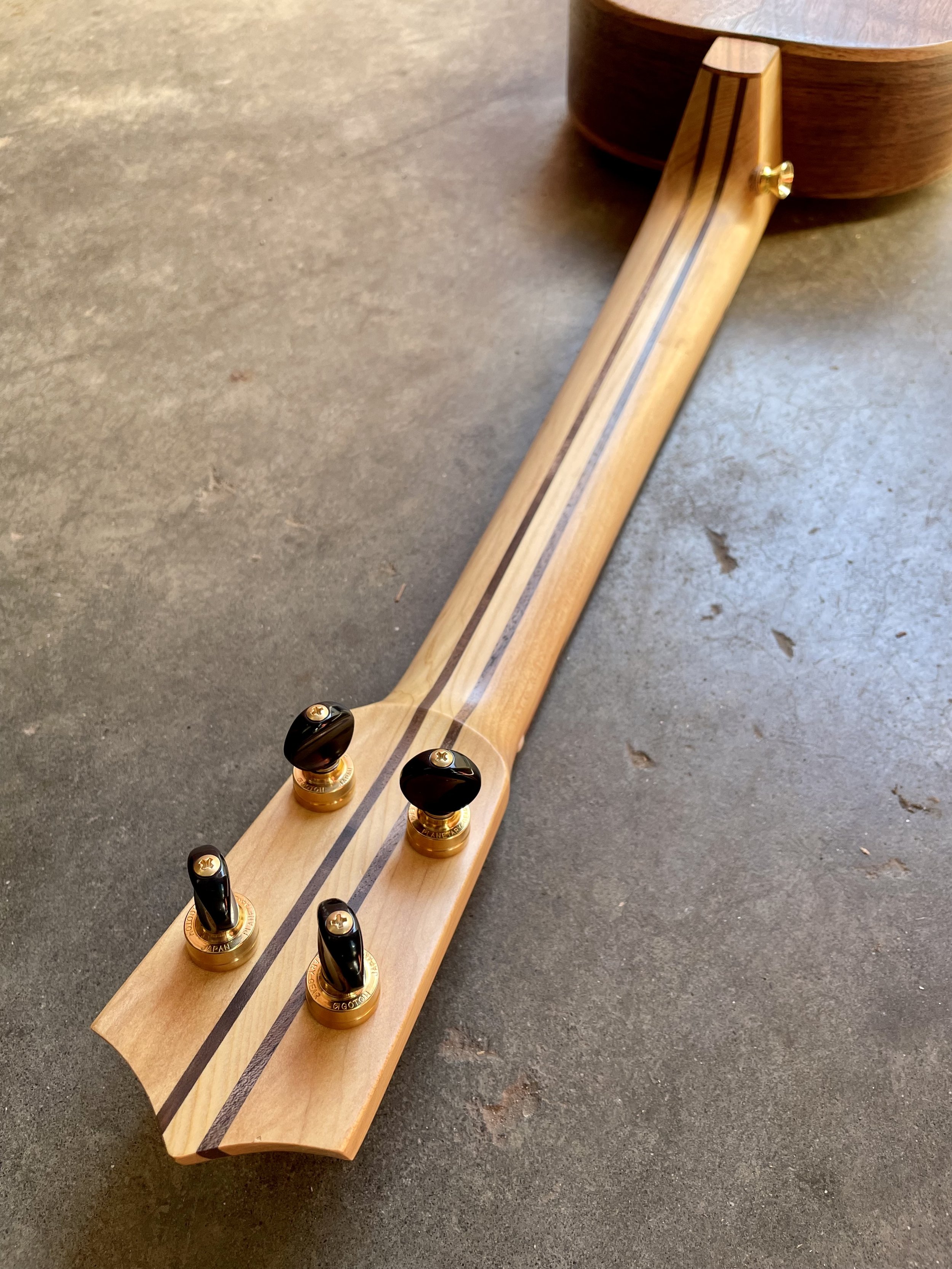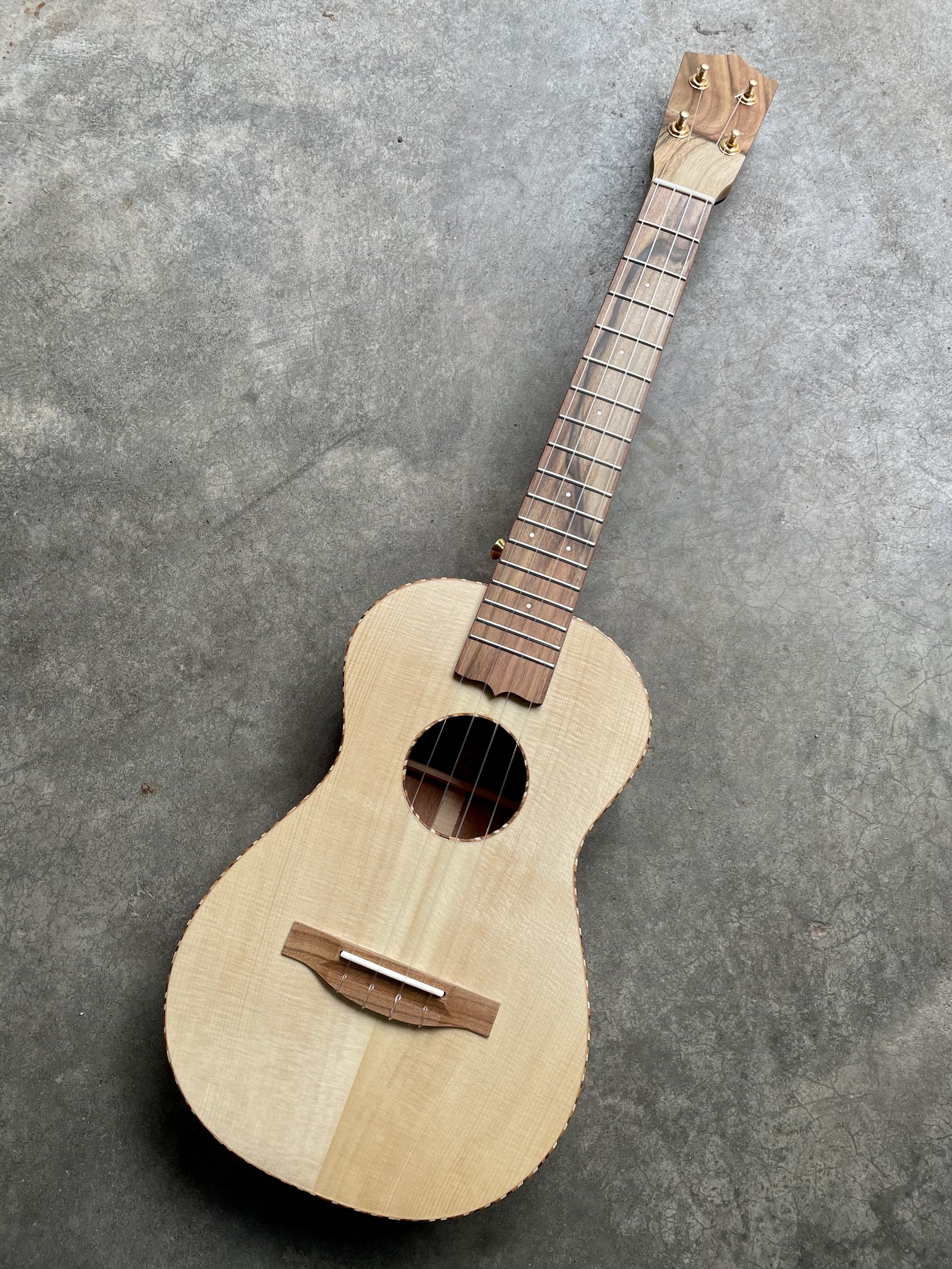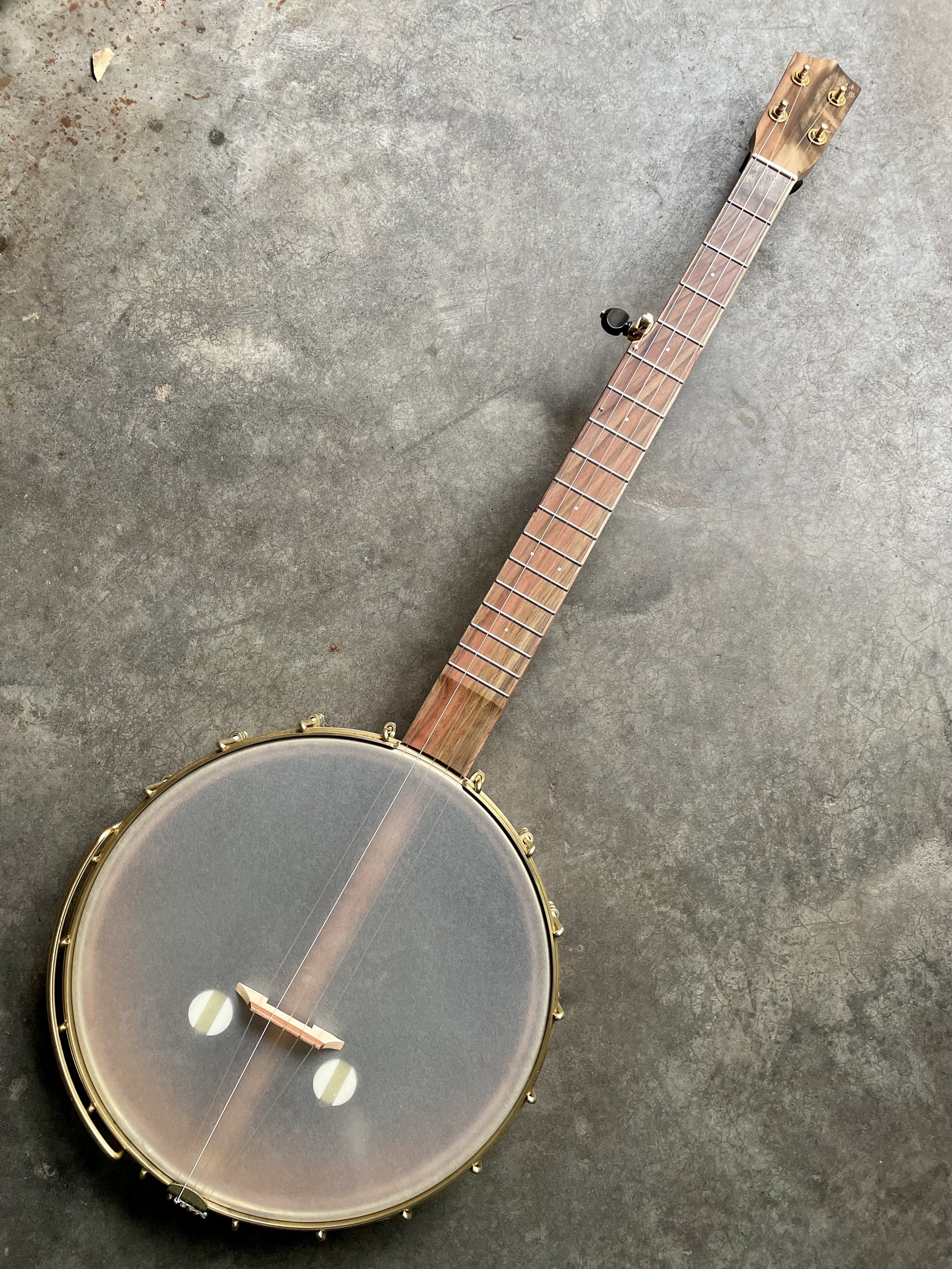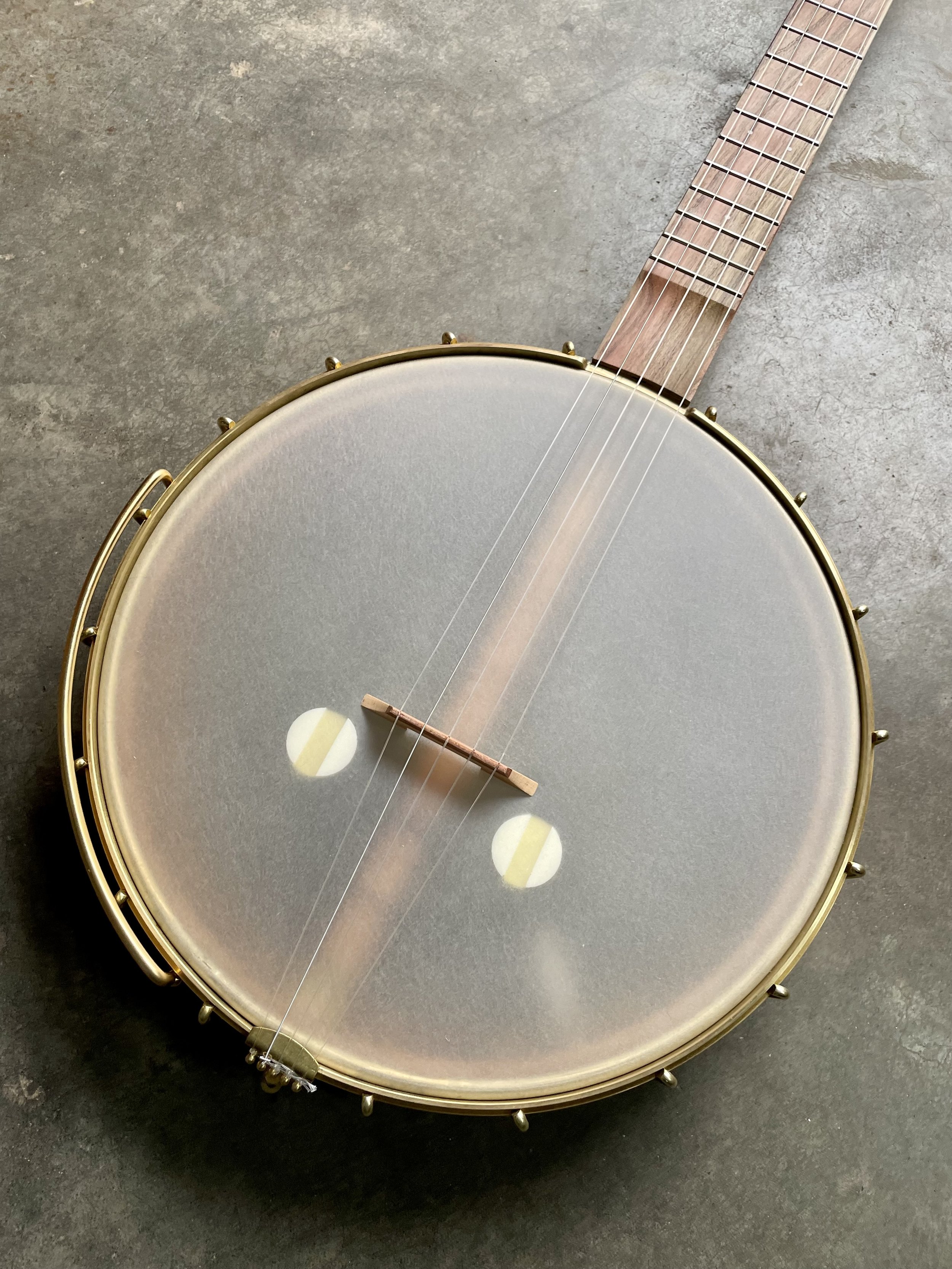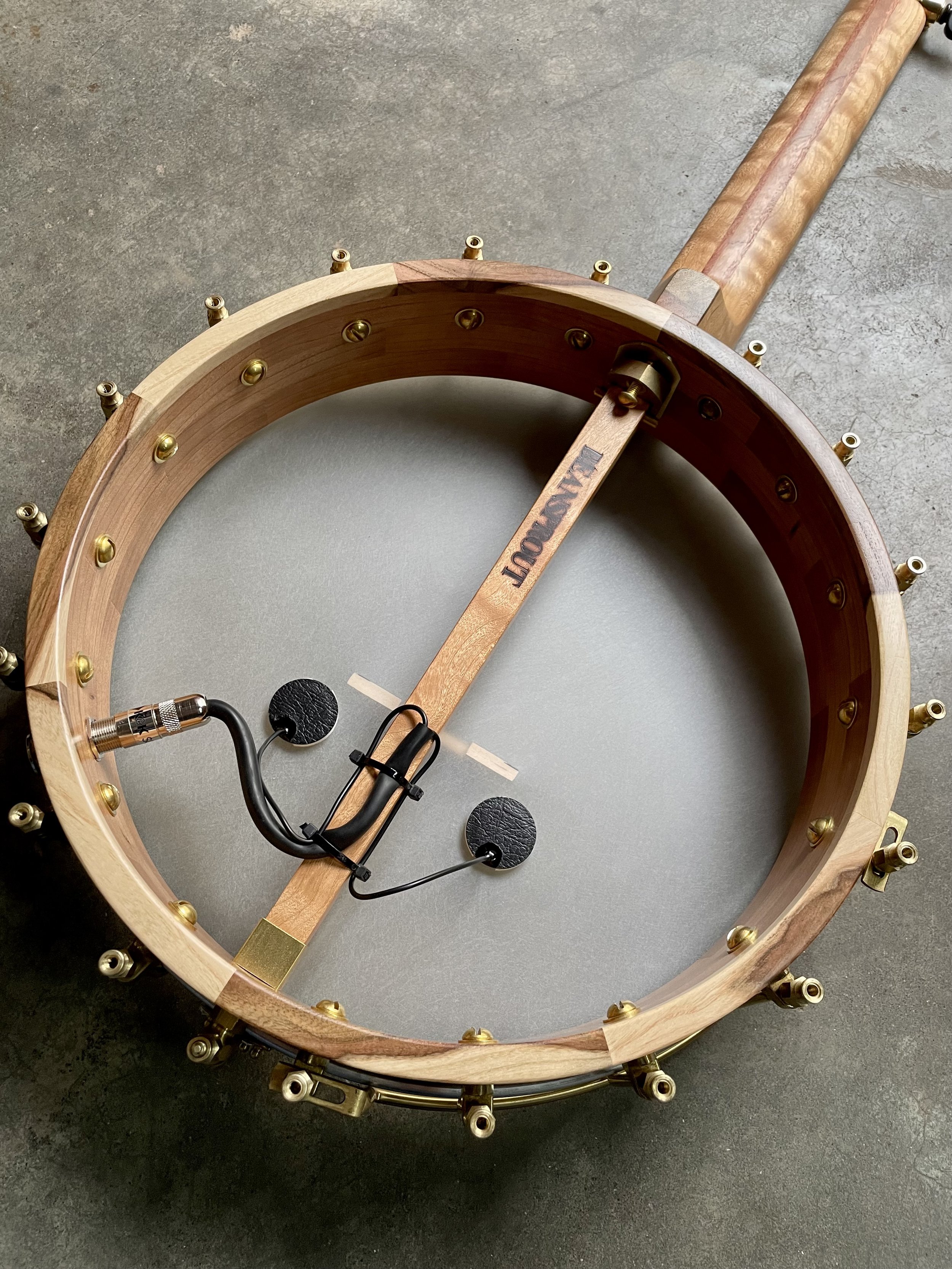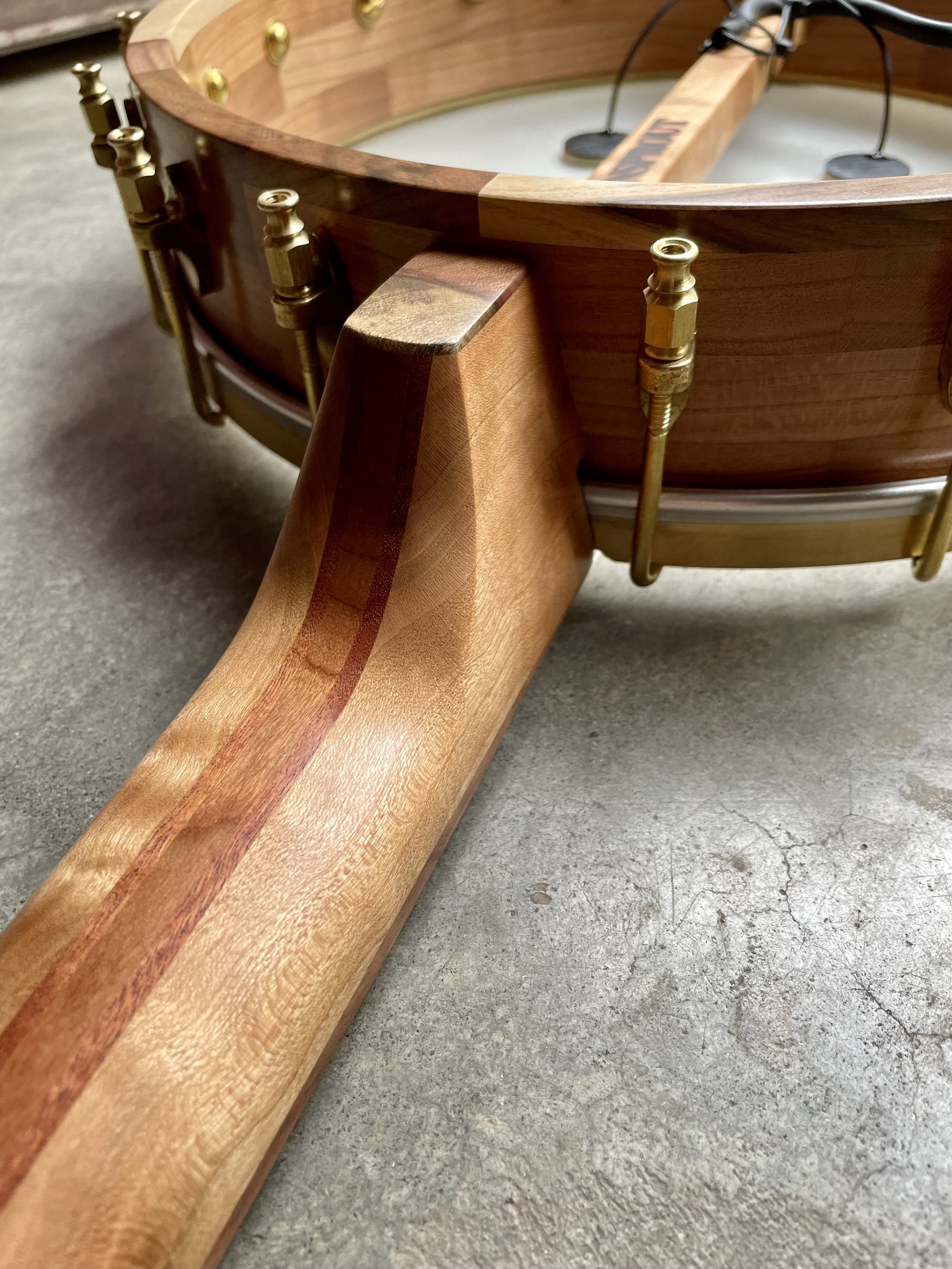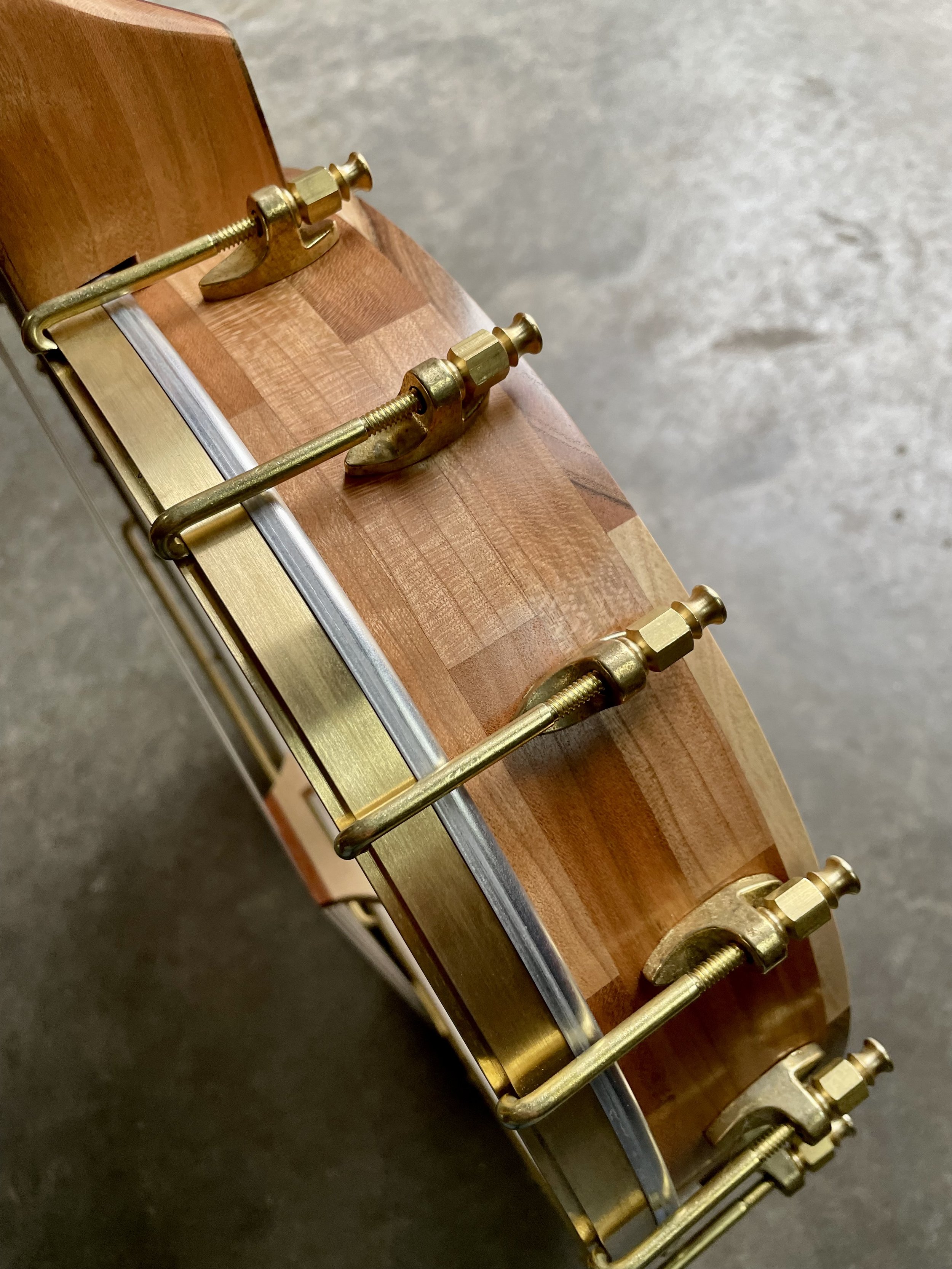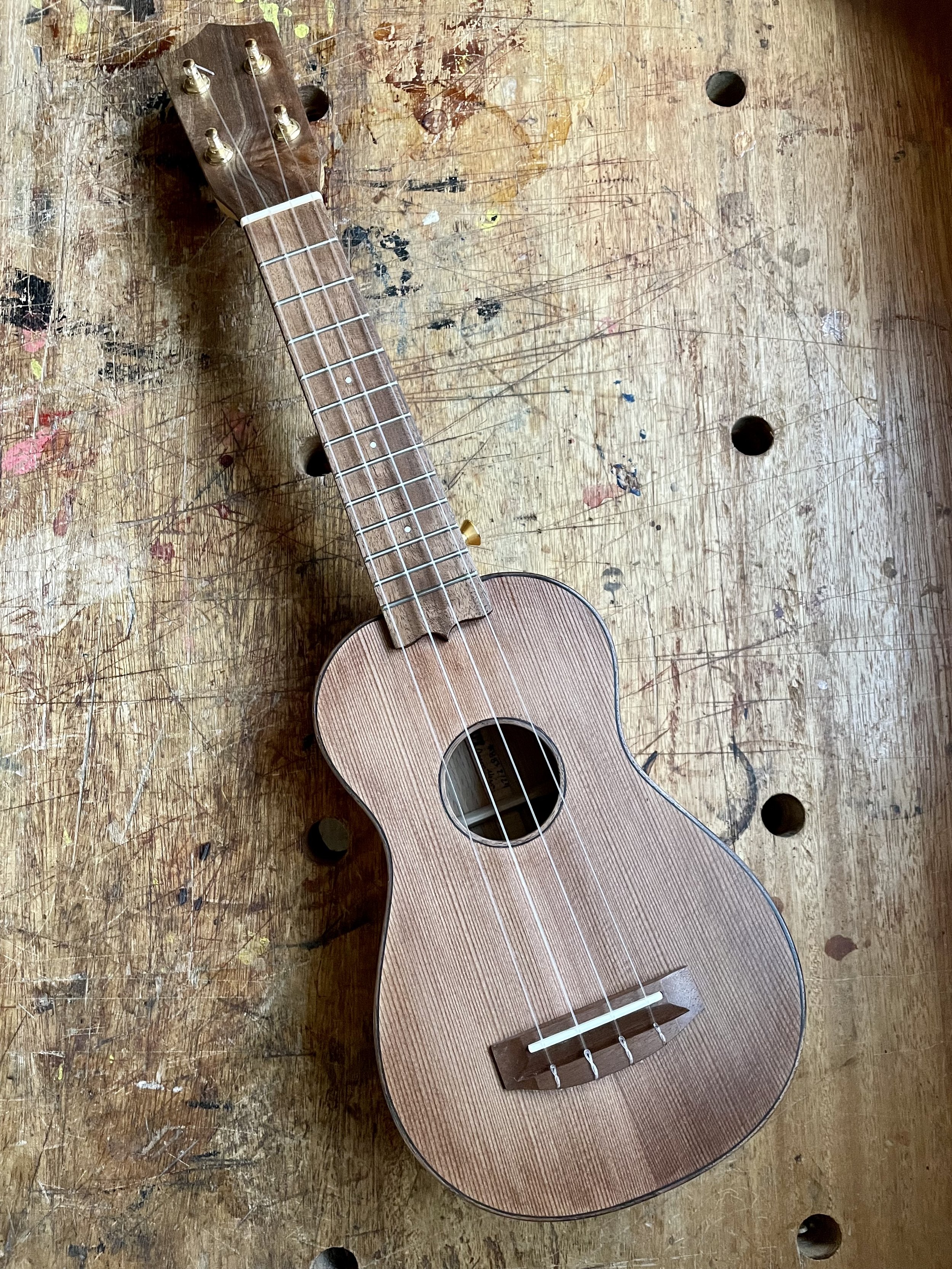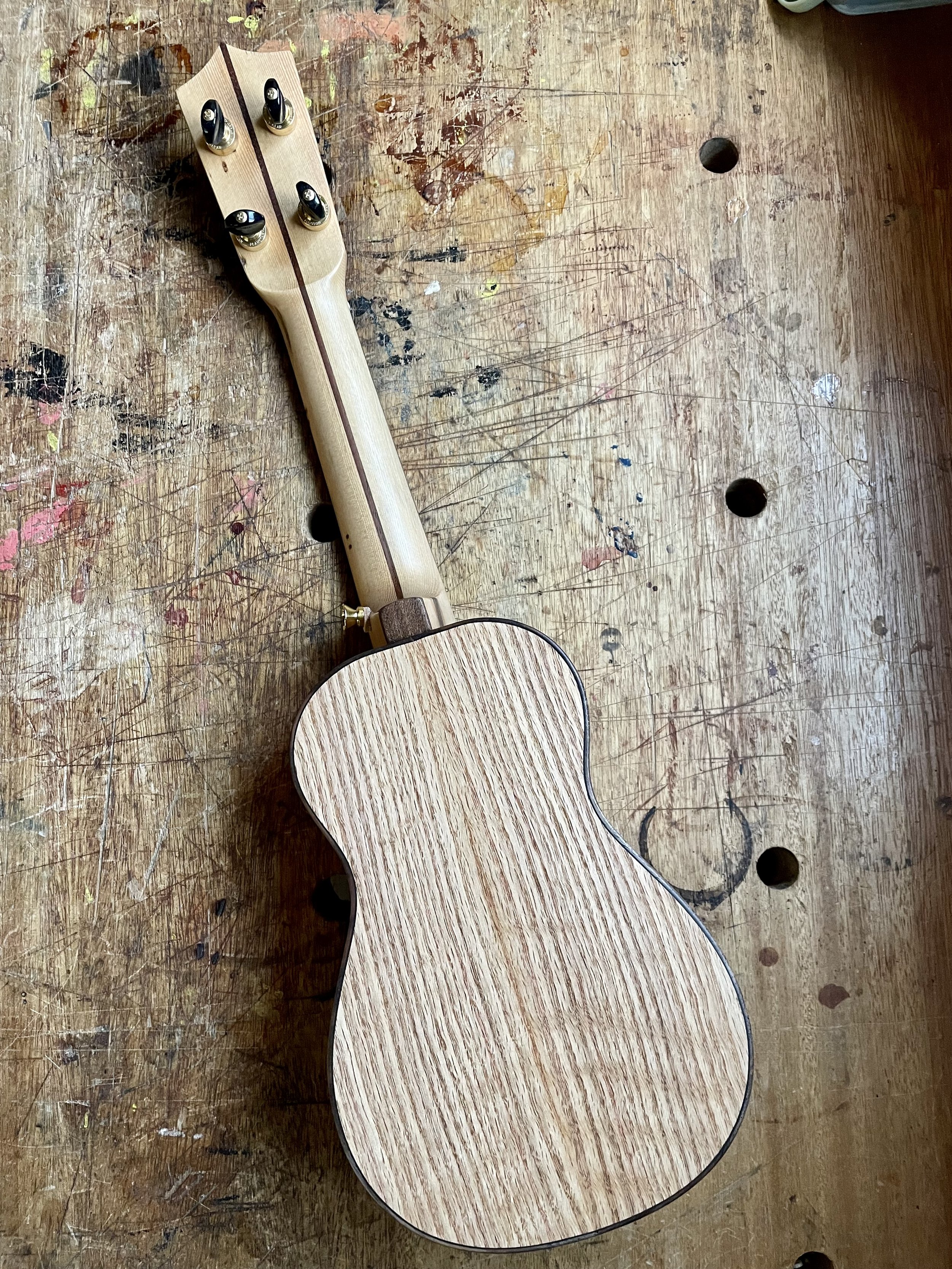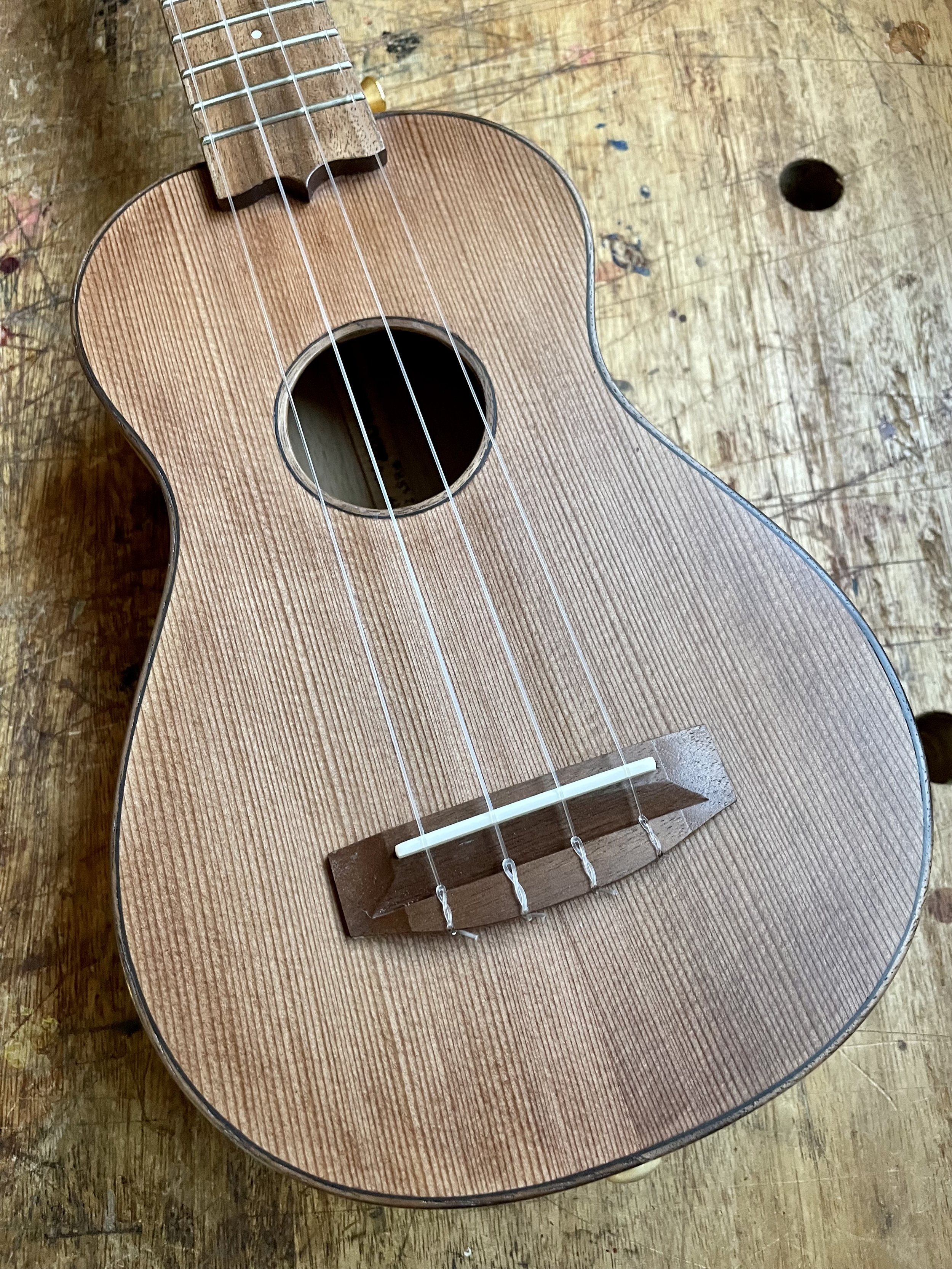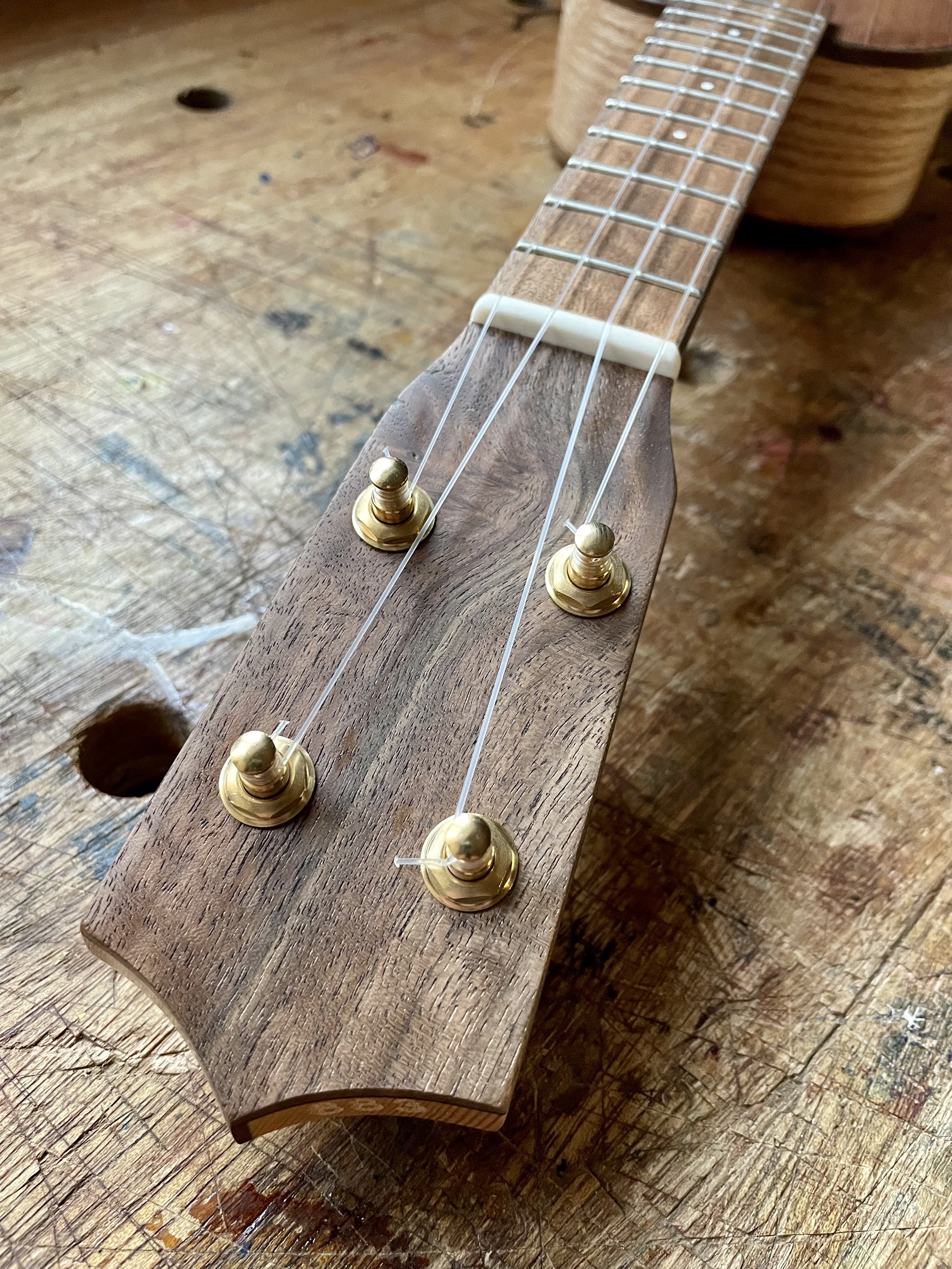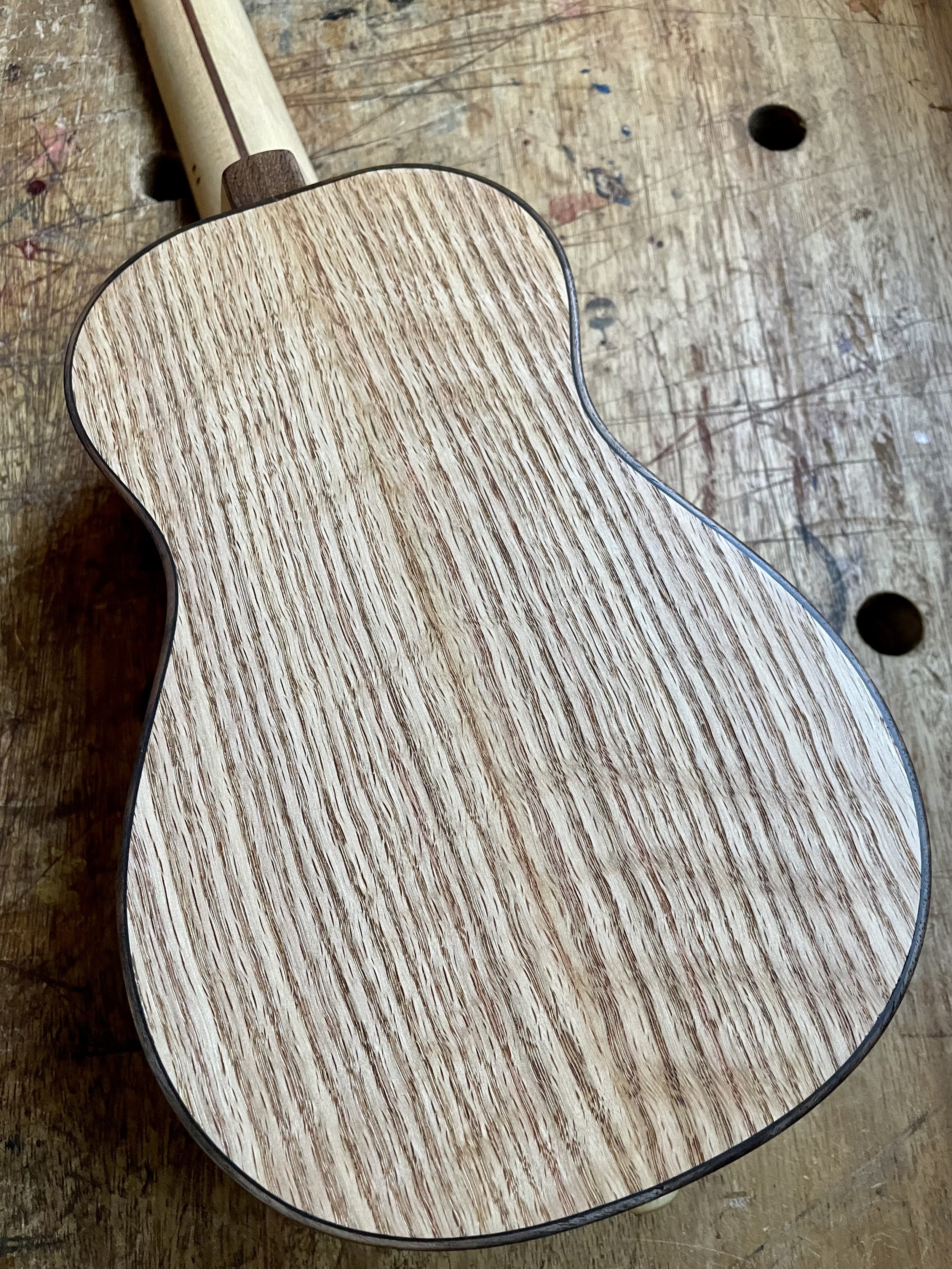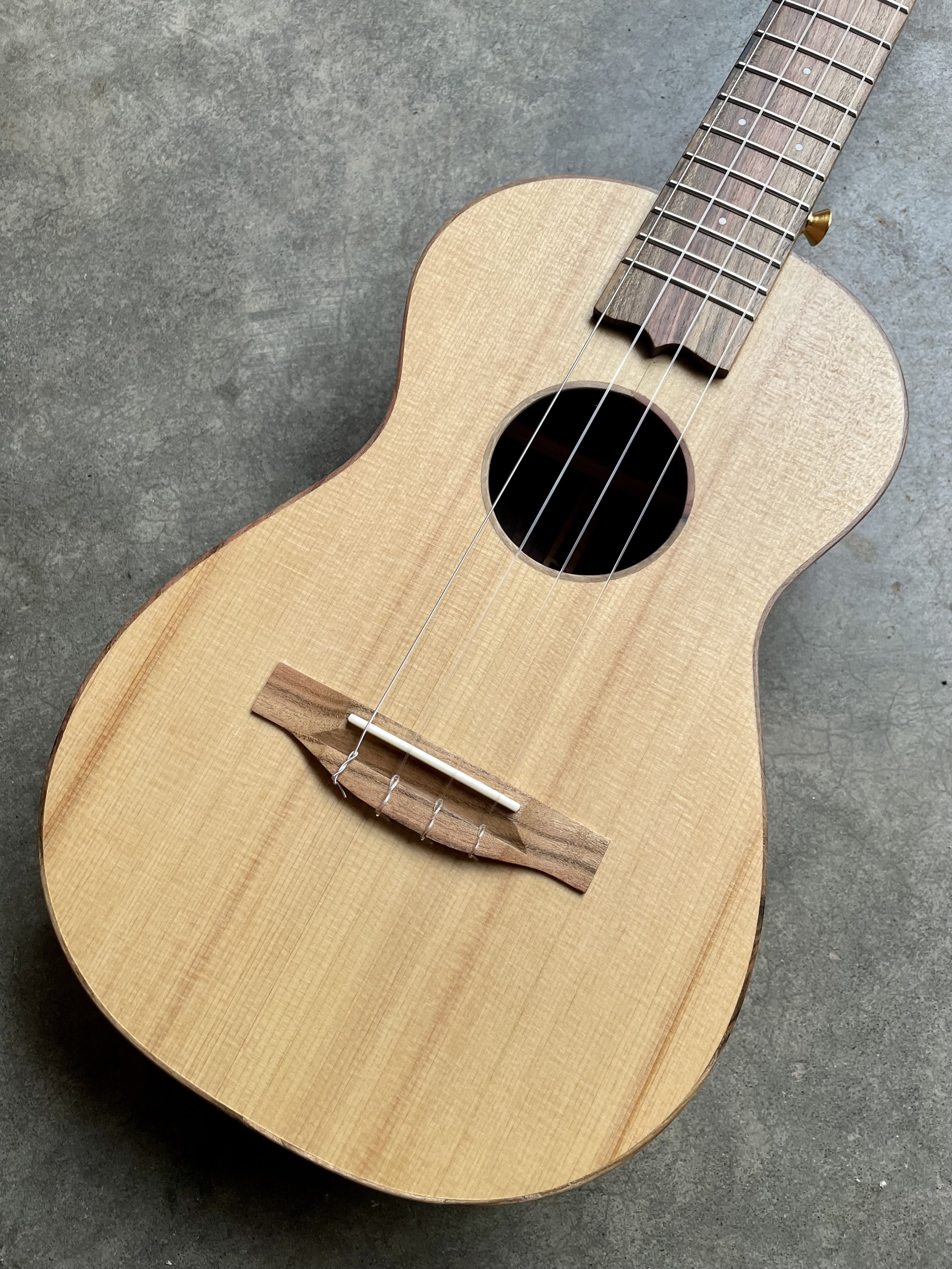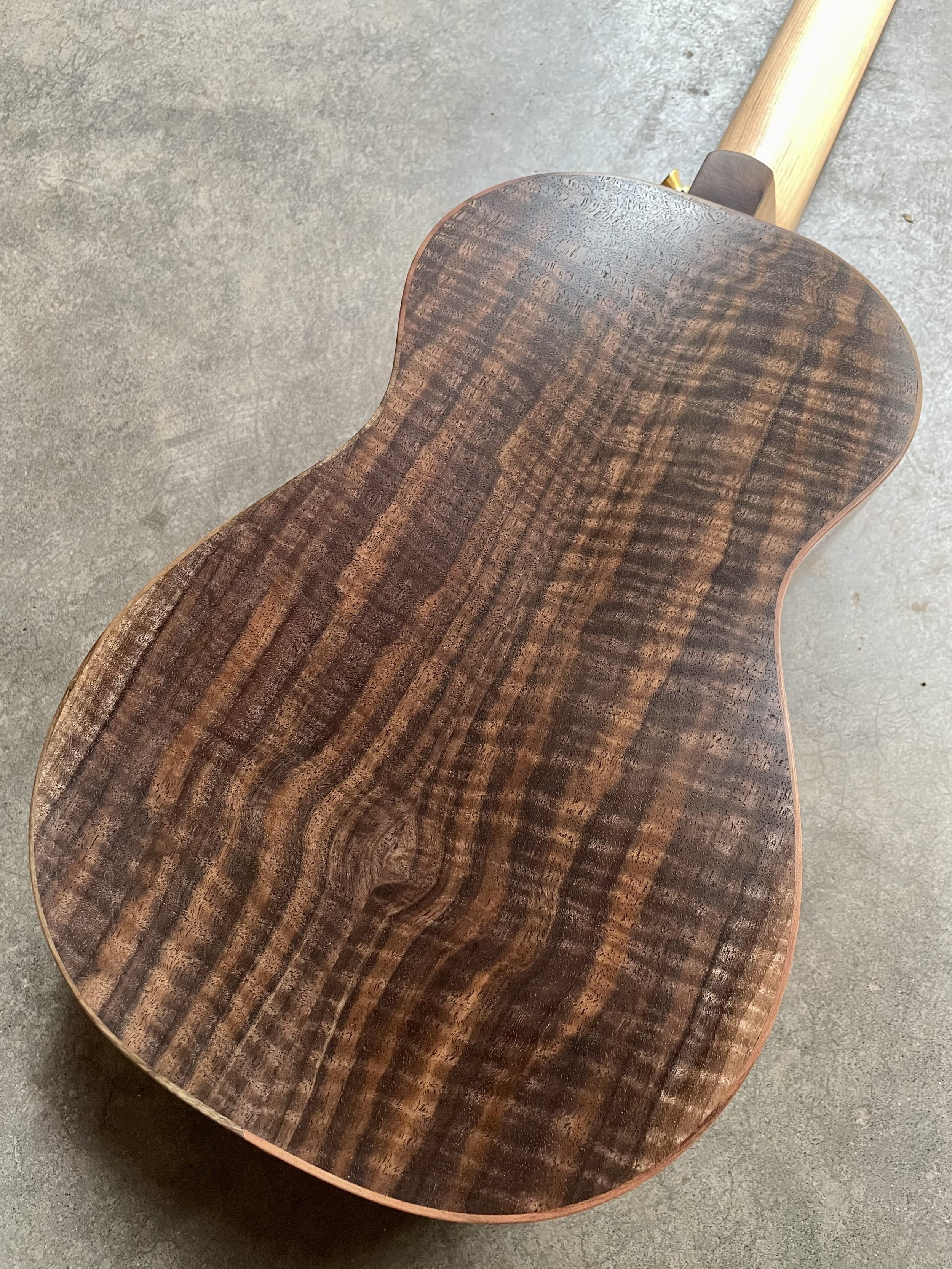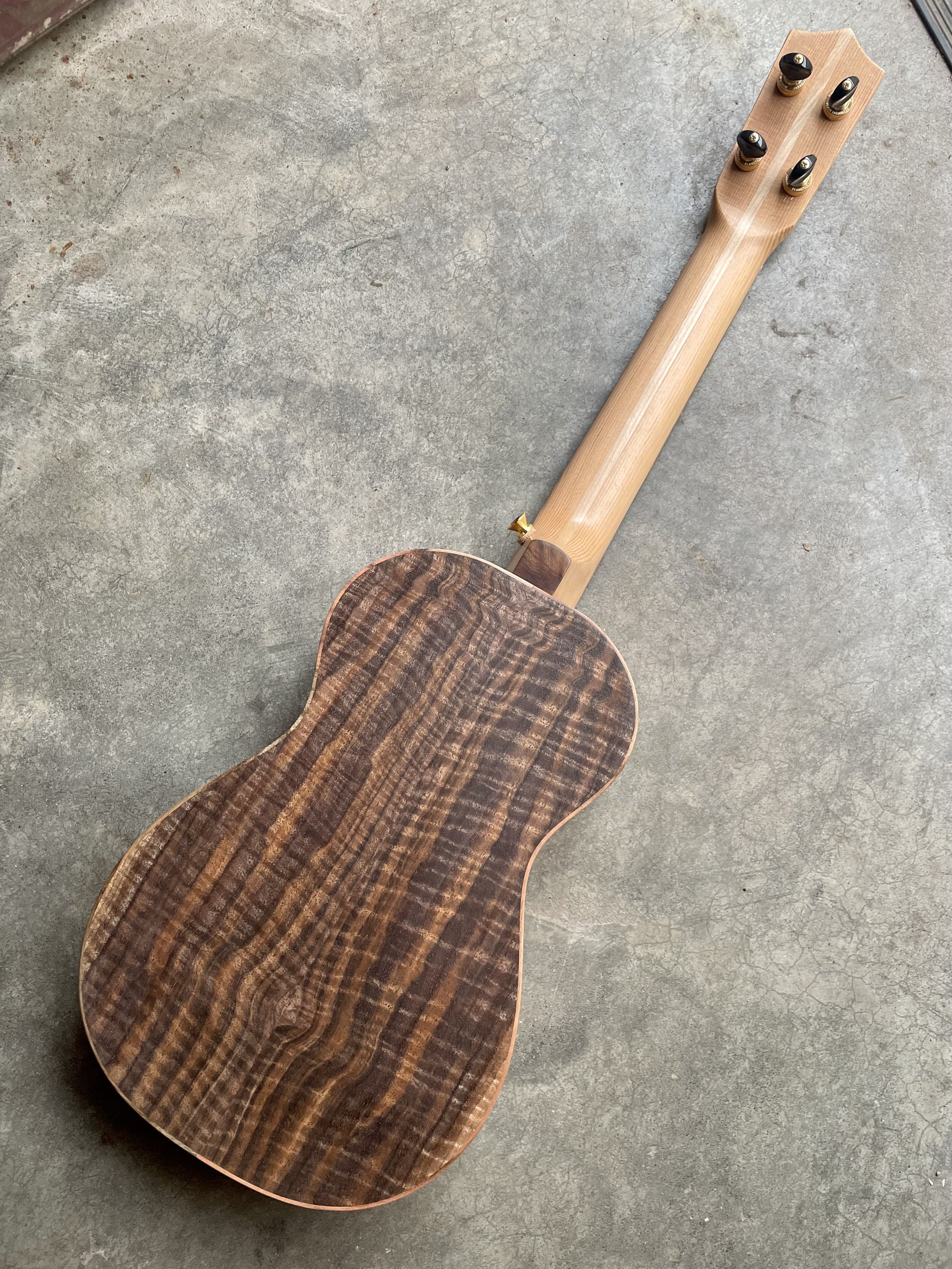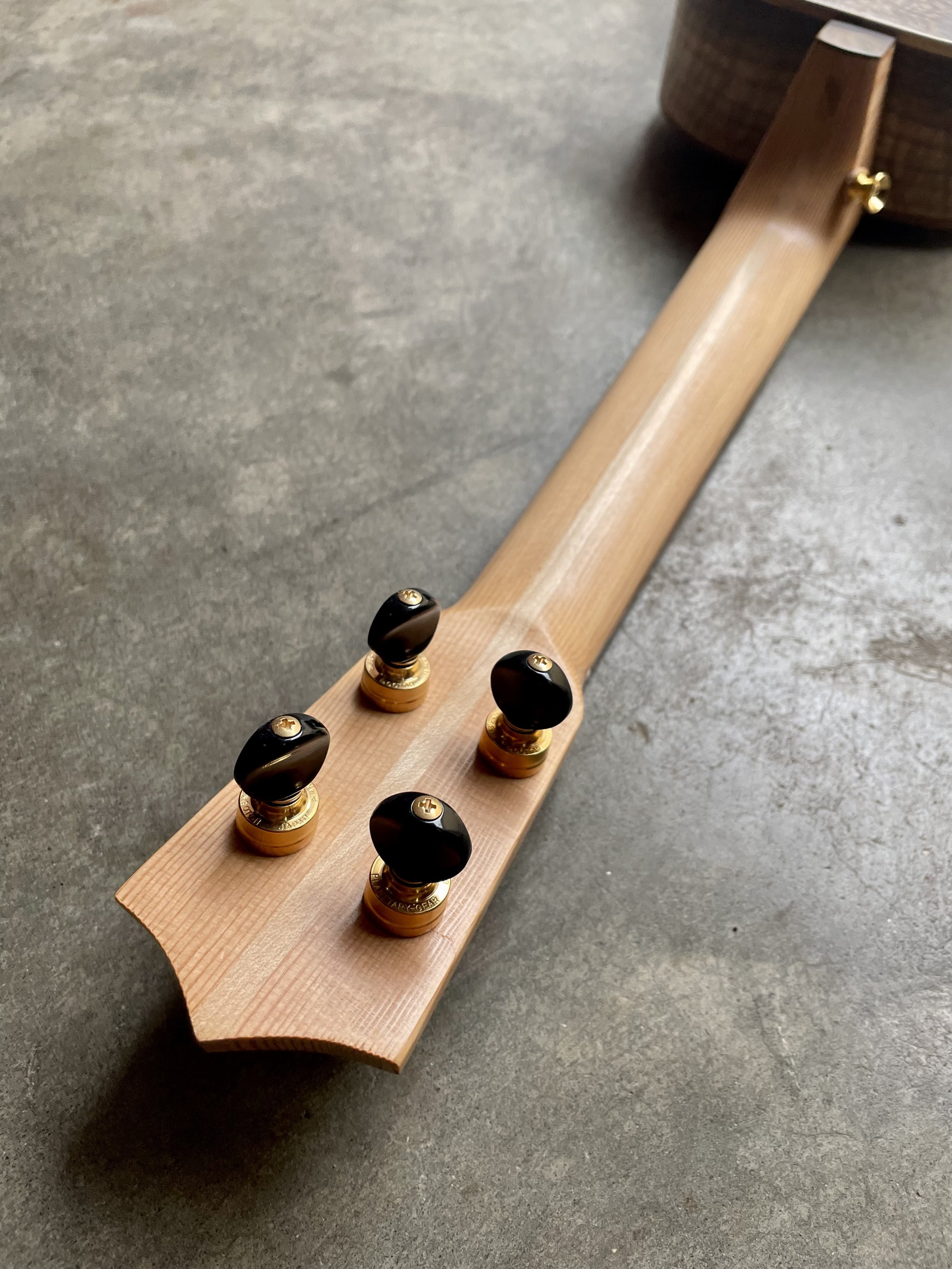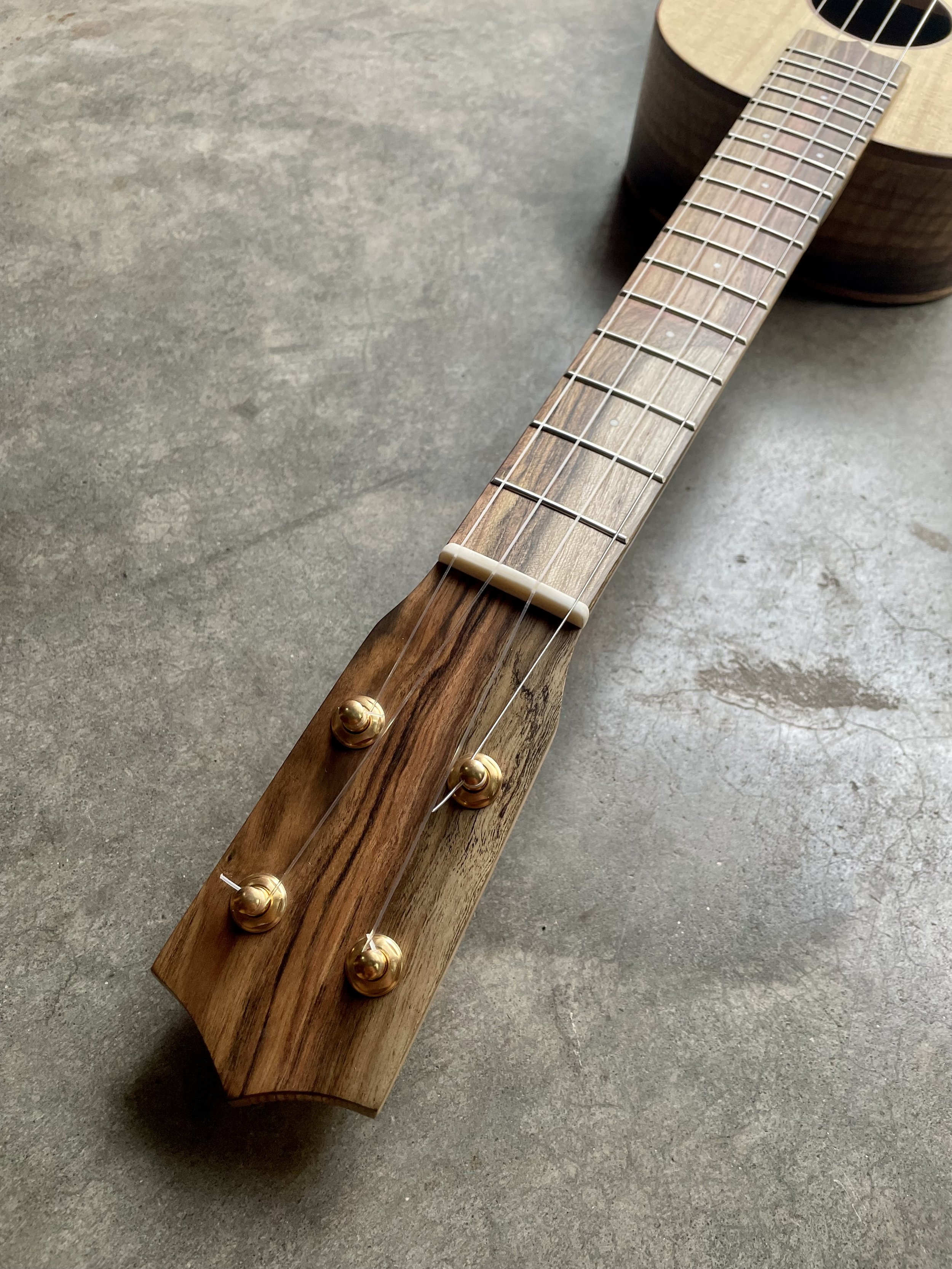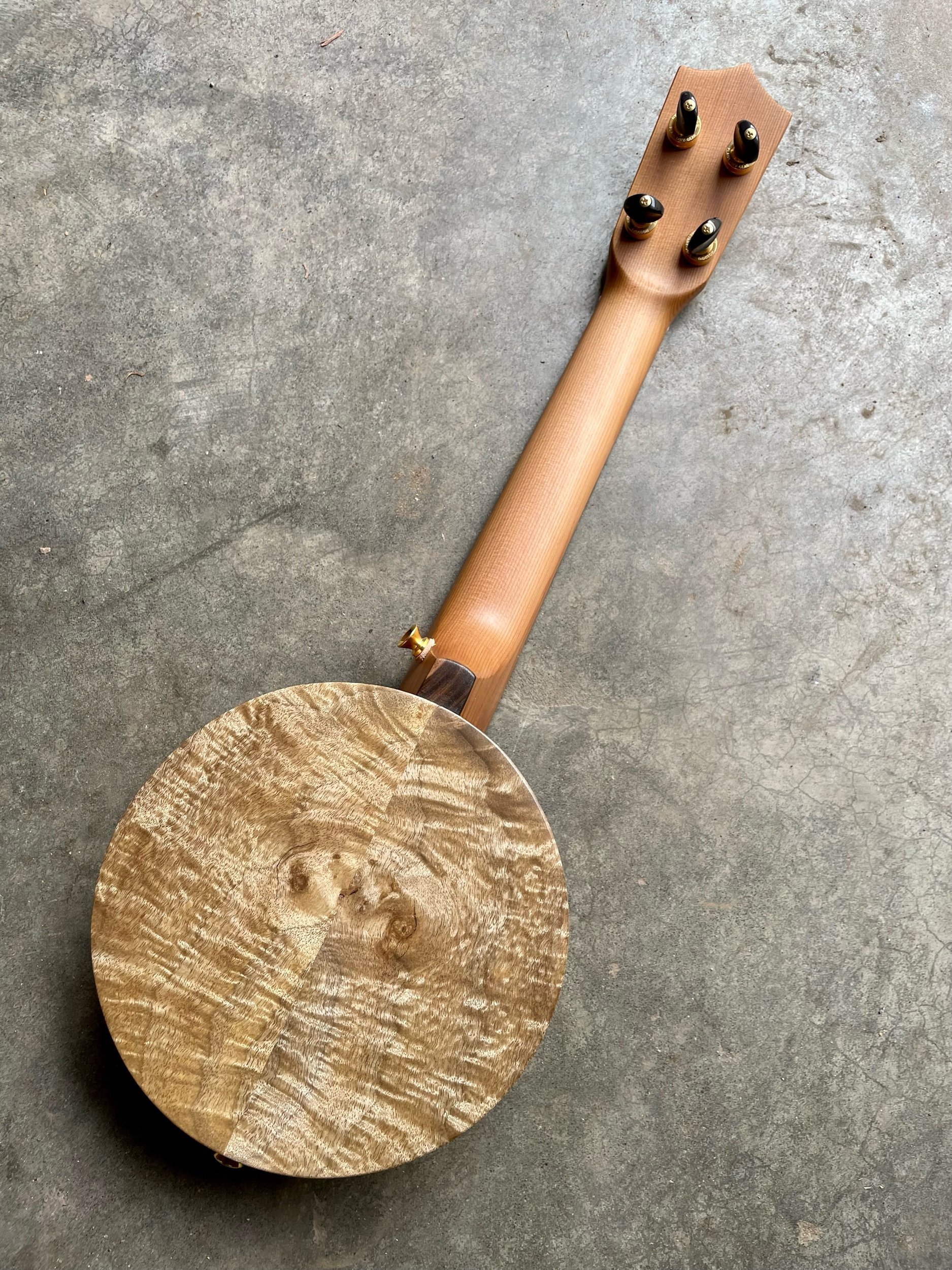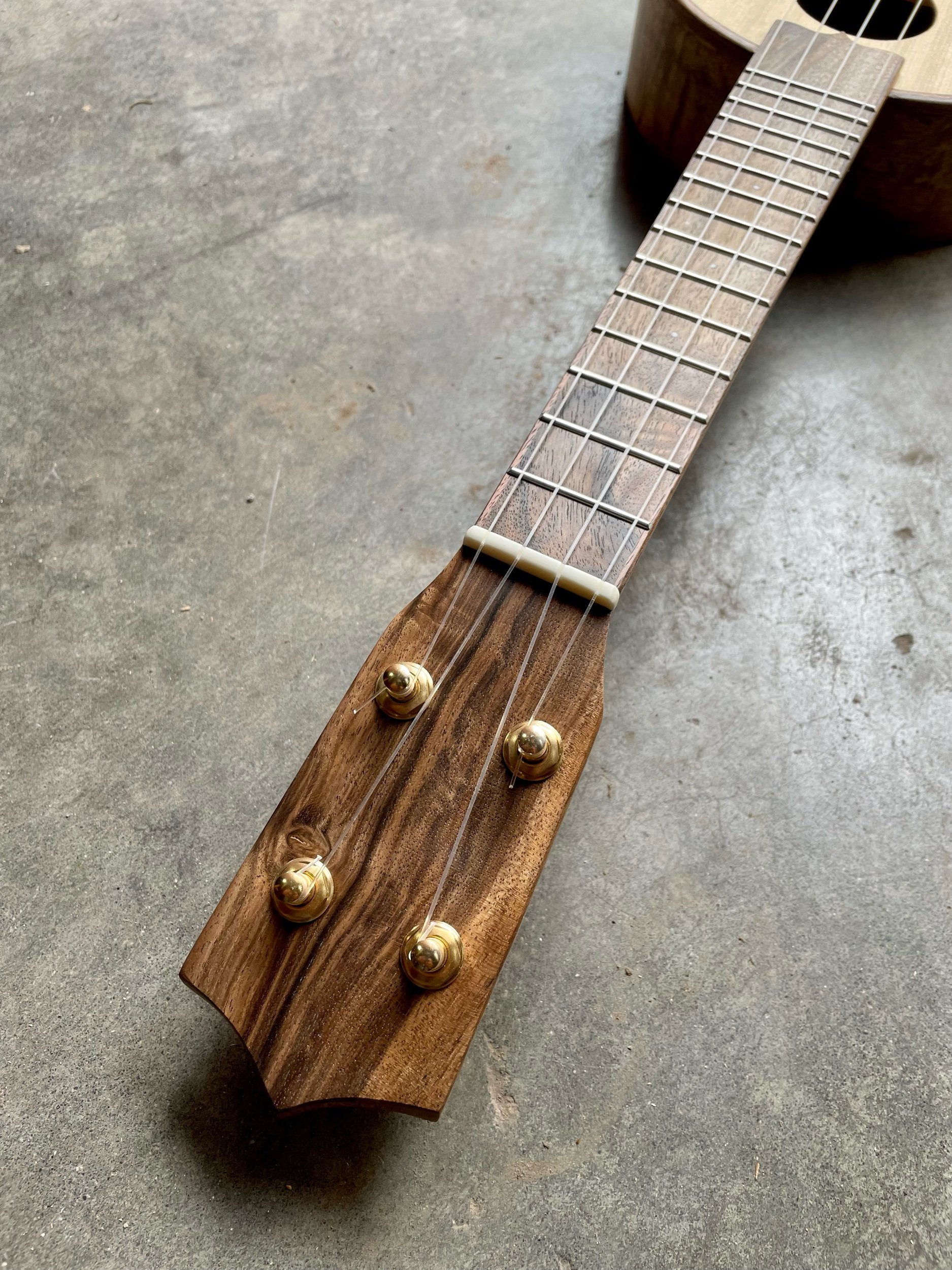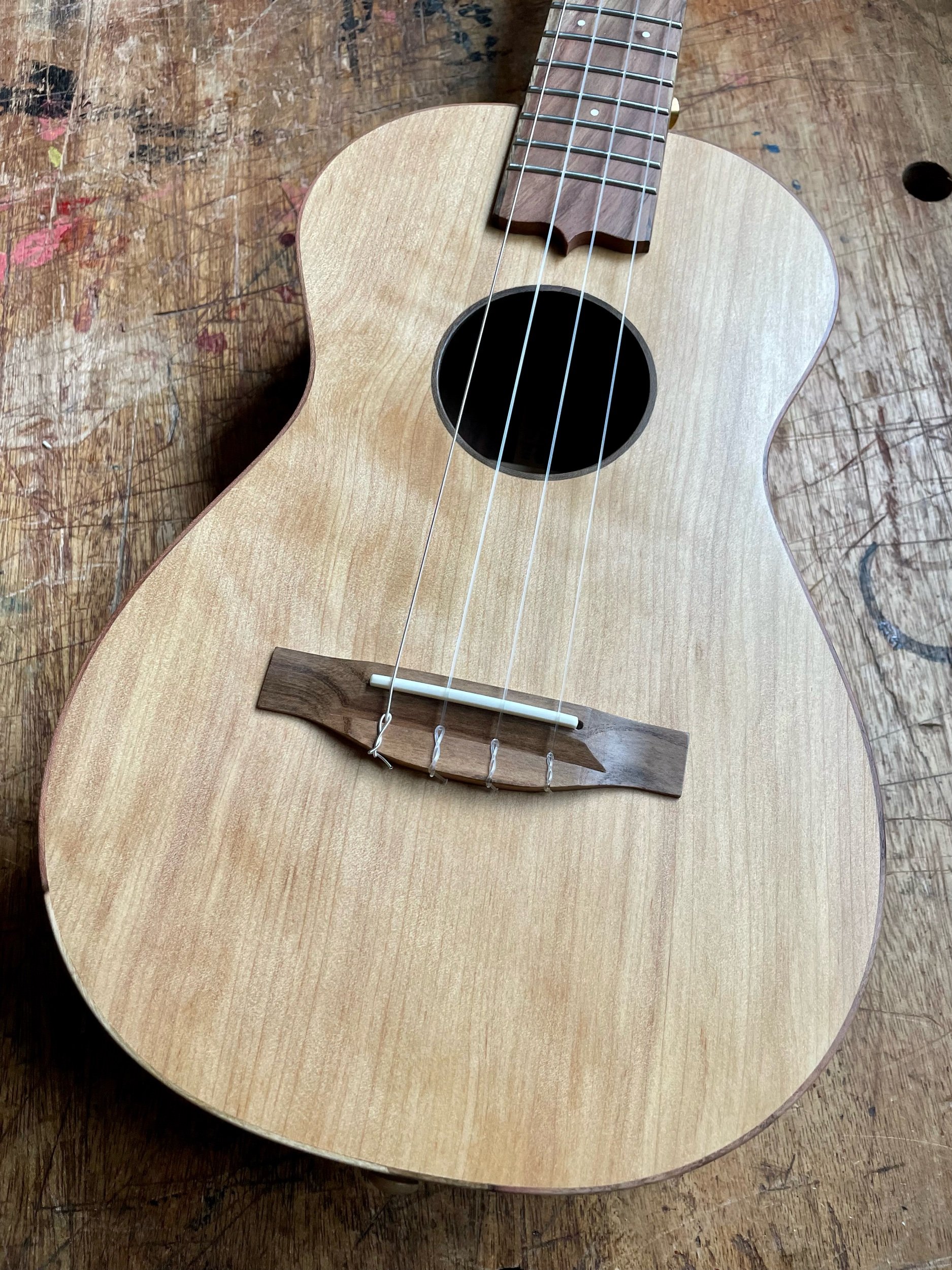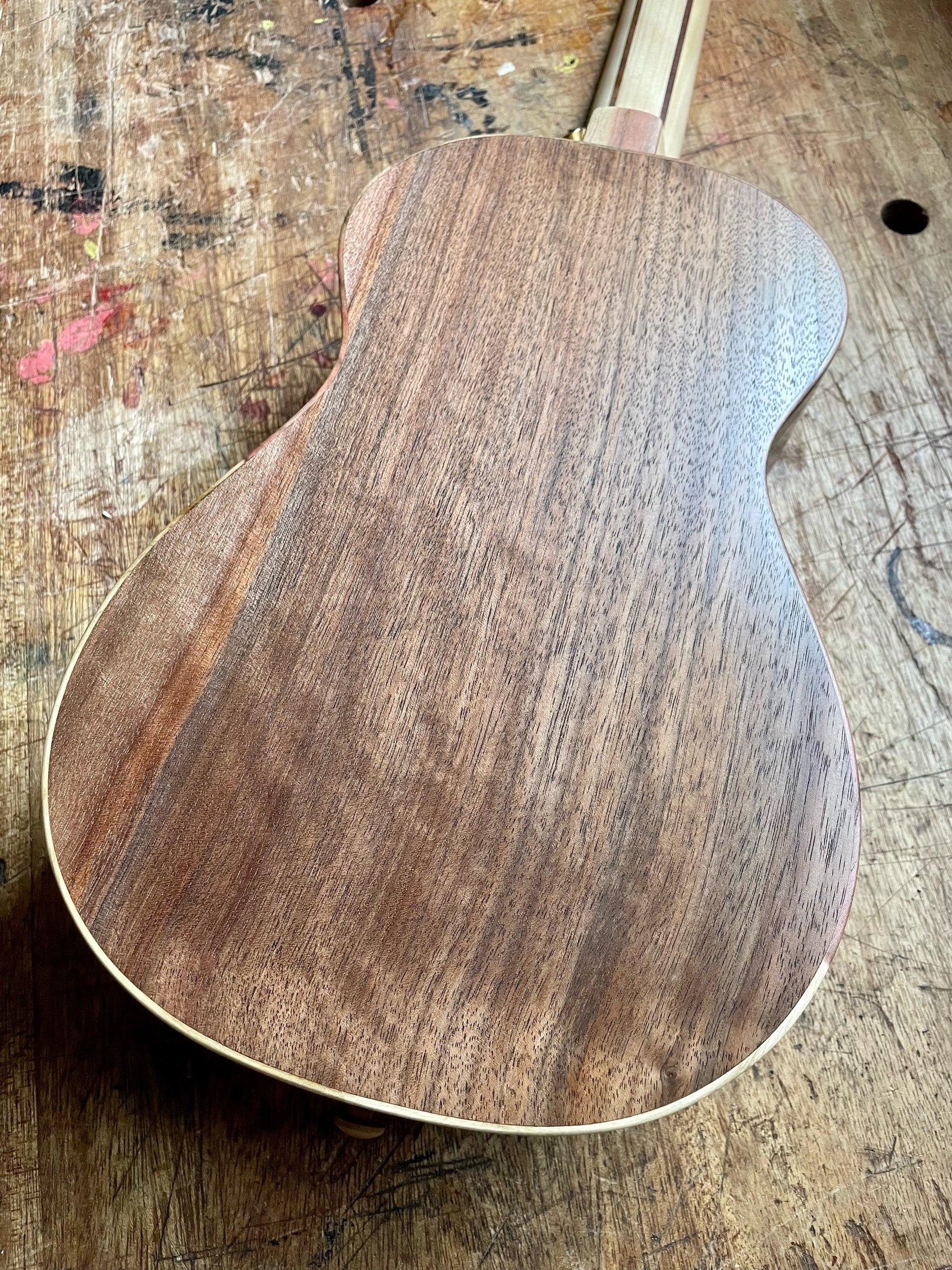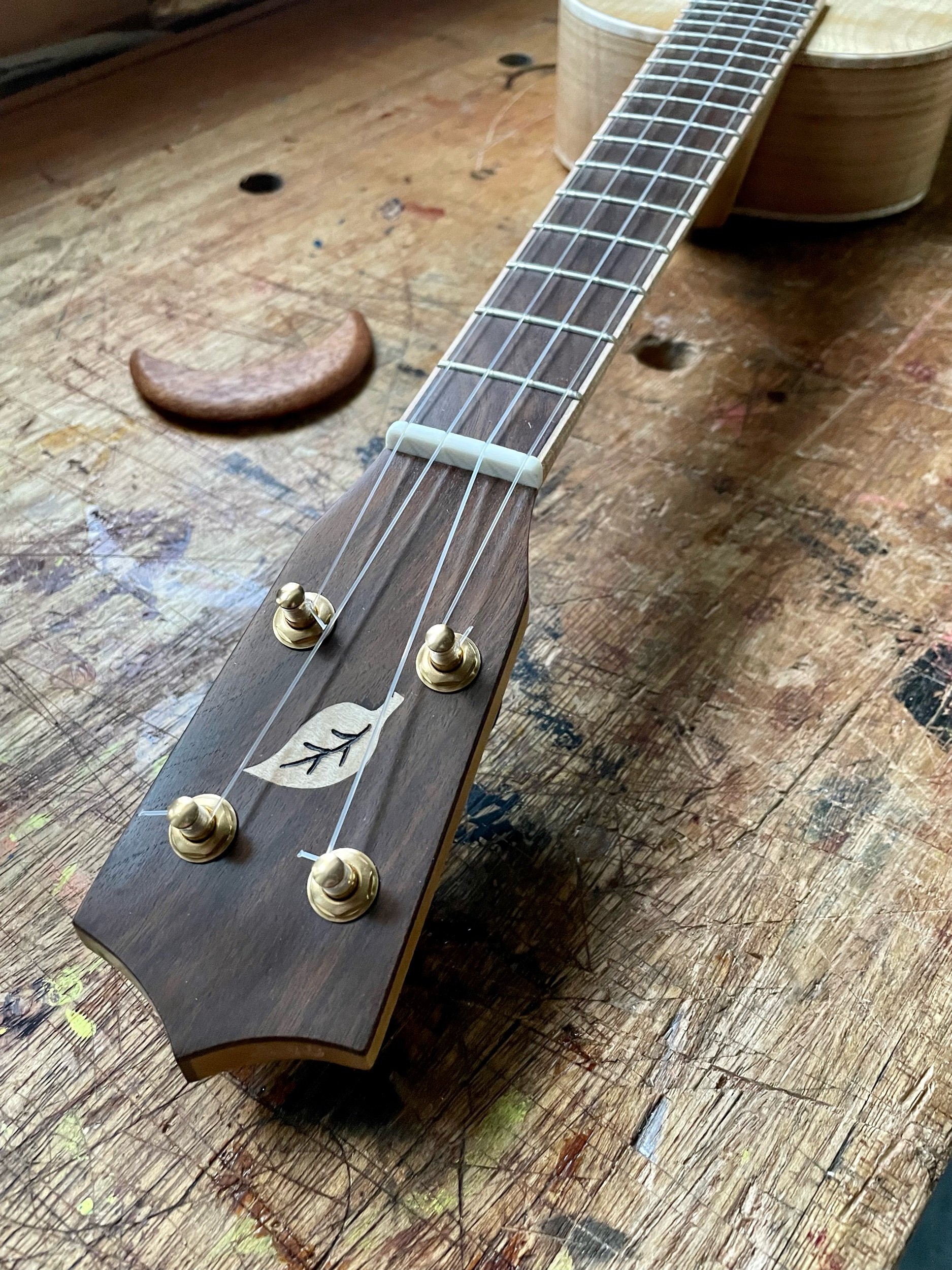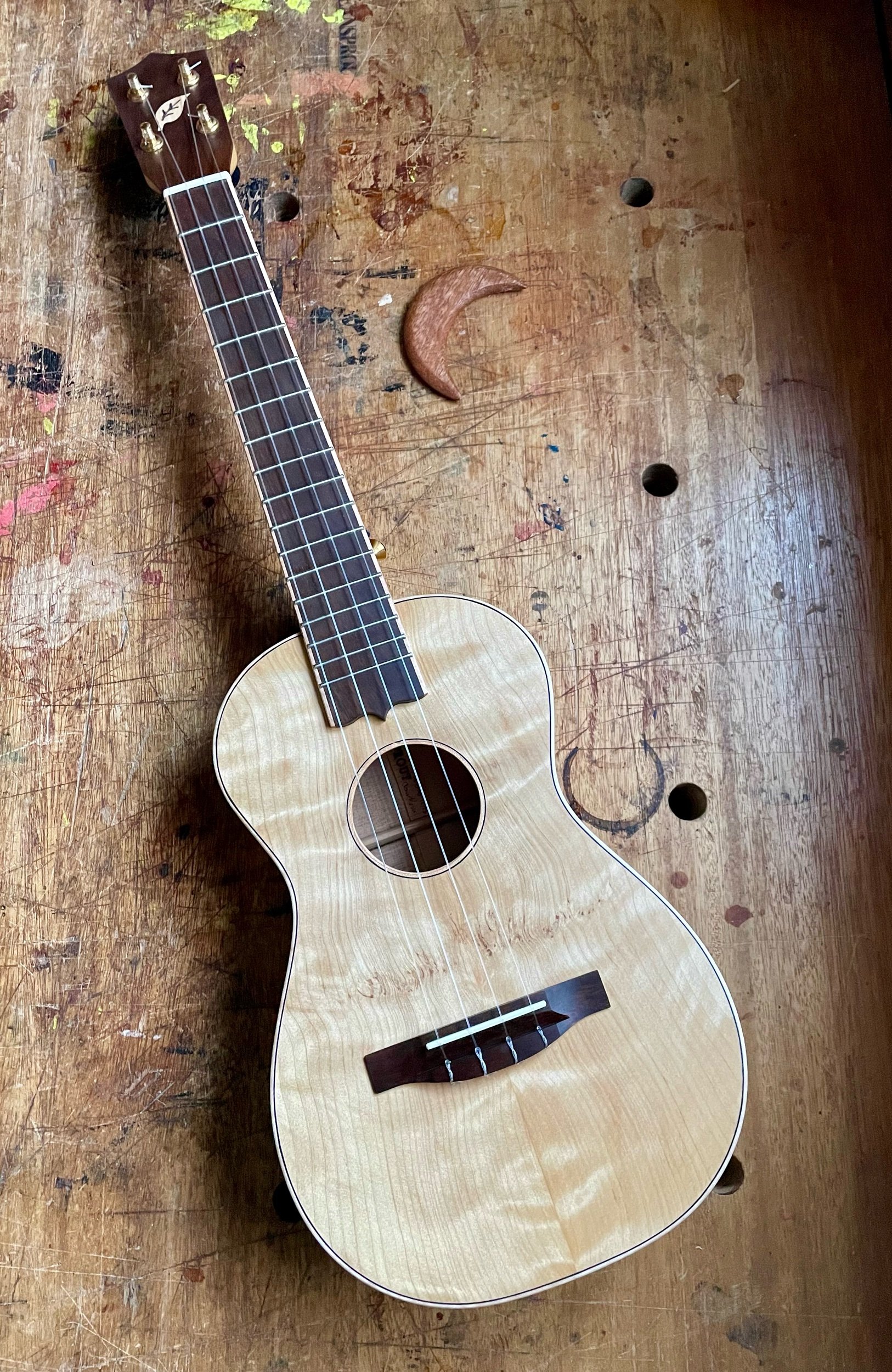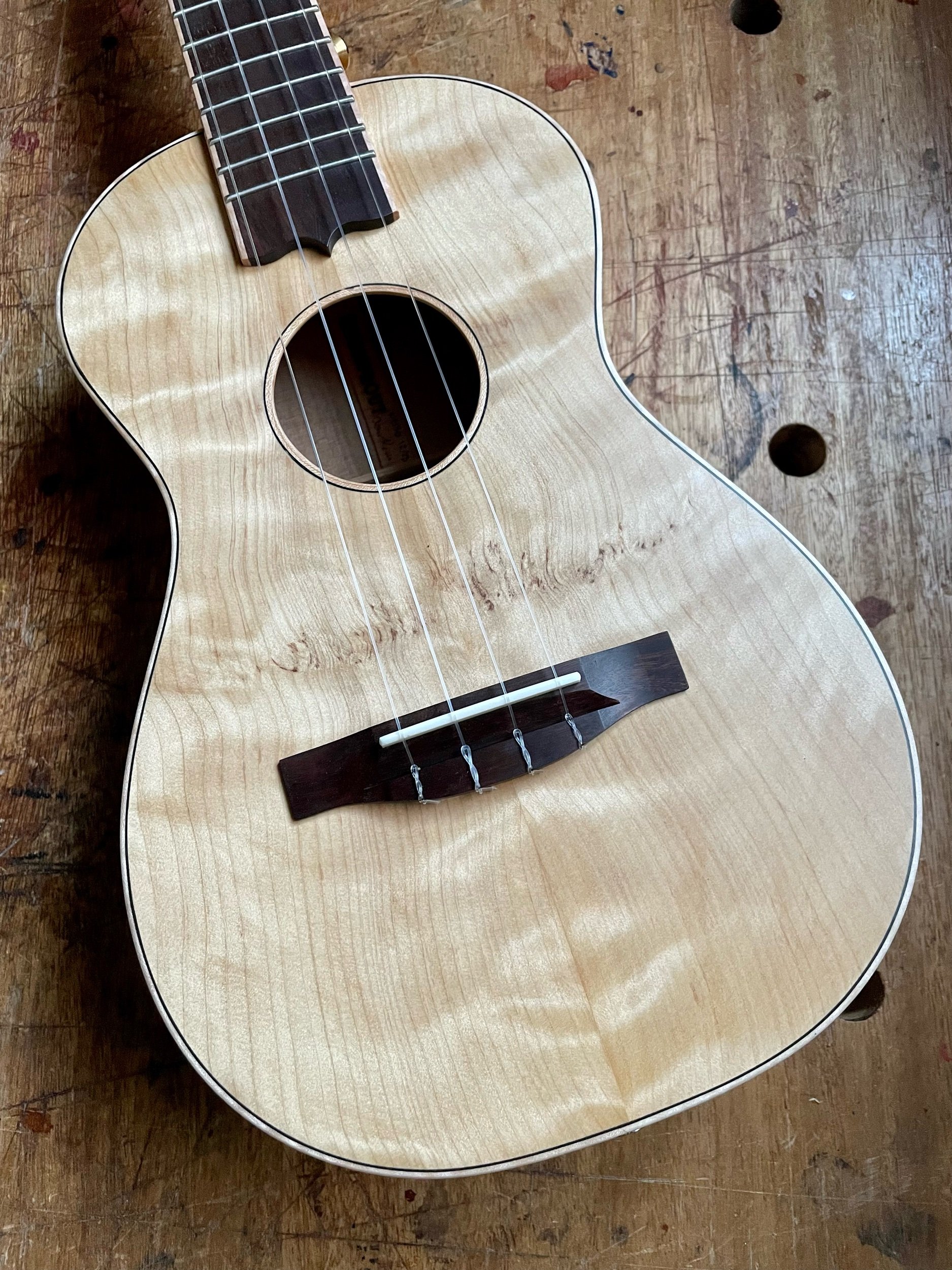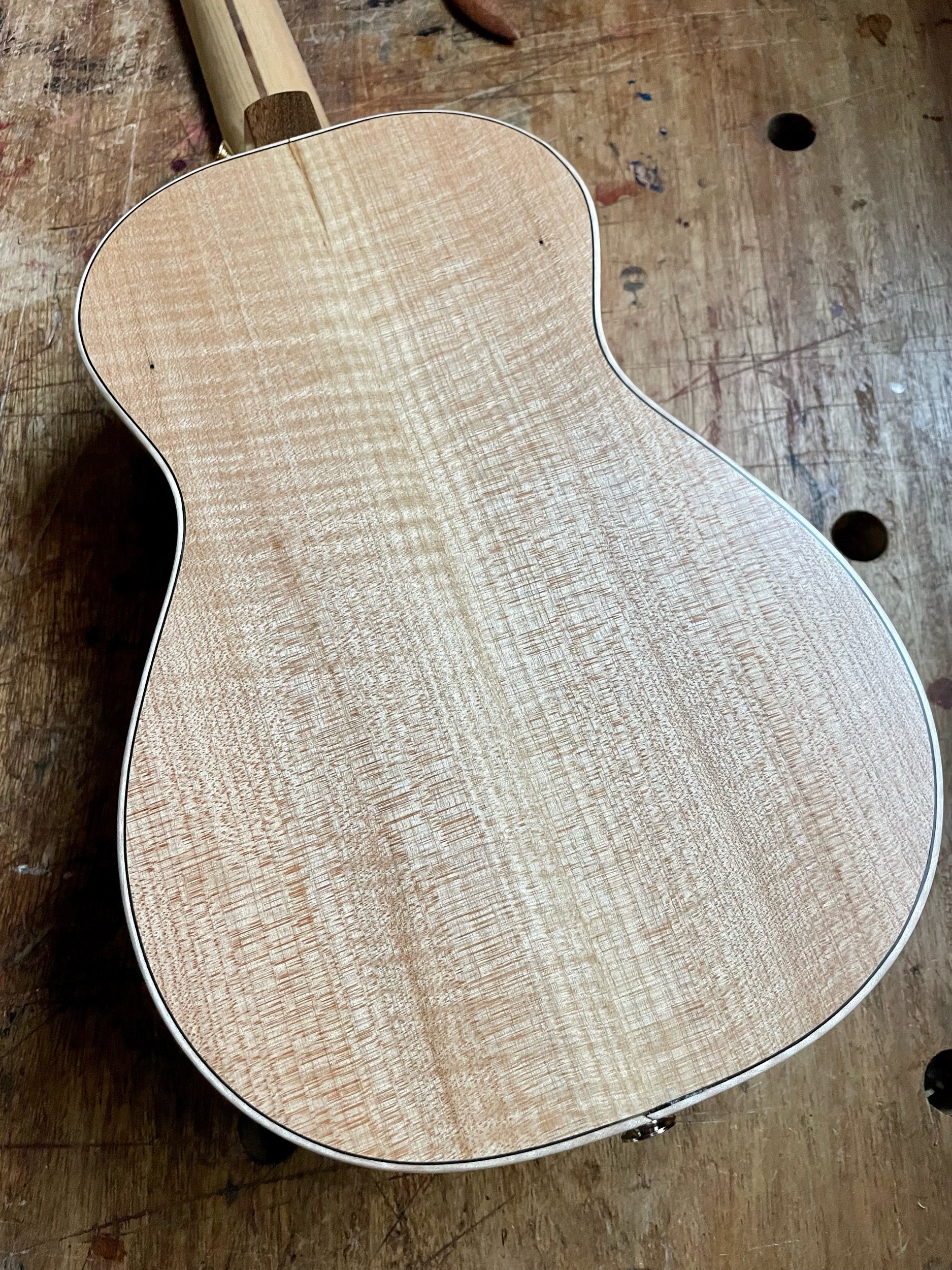All Myrtle instruments are always a favorite of ours. It feels like our Koa, as it comes from Oregon. This particular mastergrade set came from luthier Jayson Bowerman, as it was too small to use for his guitars. It also has Myrtle binding, fretboard, headplate and bridge! The neck is salvaged fir, with some evidence of its past life as a floor joist. It is strung gcea, which is a fresh sound when you are expecting the more common dgbe range. It has a 1.5” nut width and a K&K pickup as well. It’s off to a repeat customer. Cheers Tom!
#899- Maple and Texas Ebony Tenor Banjo Ukulele
This banjo looks simple and classic to me, with an attitude that seems older than it really is. The maple is all cutoffs from other banjo projects and the Texas ebony is from a retired builder’s shop. It is finished with Amber shellac and wax, which is a little glossier than I usually do, but adds to the antique feel. It is loud, poppy and easy to play. I hope Melissa loves it. She’s an amazing person and friend and I’m honored to have built this for her.
#860- Cedar and Myrtle Kingdom Era Soprano Ukulele
This soprano ukulele grew out of my research into historic Hawaiian instruments of the 1880-1890’s. My model is based on an instrument called the Machete, a 4 string folk instrument that the first luthiers brought from Madeira. The scale length is 13.5” and the original tuning was dgbd, which changed over time to our familiar gcea. I used the tools, techniques and materials of the original builders with a few modern improvements. This is not a copy of one builder’s work, but instead my own design inspired by their output.
The top is Western Red Cedar from near Bend, OR, provided by luthier Jayson Bowerman. The curly Myrtle is from the Oregon Coast, from Kevin at woodfromthewest.com. The Walnut fretboard/headplate/bridge is from a local tree that I milled. The Cypress neck was salvaged from a factory tank. It has modern, geared Peghed brand tuners, modern frets in a flat fretboard, gut strings, bone nut and saddle and hand rubbed oil finish. It comes with a handmade wooden case, based off the originals, made from salvaged Fir and lined with cloth.
#861- Cedar and Myrtle Kingdom Era Tenor Ukulele
This tenor ukulele grew out of my research into historic Hawaiian instruments of the 1880-1890’s. My model is based on an instrument called the Rajao, a 5 string folk instrument that the first luthiers brought from Madeira. The scale length is 17” and the original tuning was dgcea, which includes our familiar gcea. For this build, I chose to just use four strings and call it a tenor ukulele, although I retain the body shape and size of the historic Rajao. I used the tools, techniques and materials of the original builders with a few modern improvements. This is not a copy of one builder’s work, but instead my own design inspired by their output.
The top is Western Red Cedar from near Bend, OR, provided by luthier Jayson Bowerman. The curly Myrtle is from the Oregon Coast, from Kevin at woodfromthewest.com. The Walnut fretboard/headplate/bridge is from a local tree that I milled. The Cypress neck was salvaged from a factory tank. It has modern, geared Peghed brand tuners, modern frets in a flat fretboard, fluorocarbon strings, bone nut and saddle and hand rubbed oil finish. It comes with a handmade wooden case, based off the originals, lined with cloth and made from salvaged Hemlock.
The price is $3000 including the case, plus shipping. It’s available for purchase here.
***** If you are an international customer (outside of the US), please note we may need to charge you additional shipping fees depending on your location. You will also be responsible for any customs fees imposed by your country. Thanks! ******
#885- Toon (Australian Cedar) Tenor Ukulele
Toon is an Australian wood that is an invasive species in Hawaii. I was given some by Casey, one of the caretakers of Ho’oulu ‘Āina, a 100 acre nature preserve dedicated to food, medicine, housing and community on Oahu. Toon is also called Australian Cedar or Australian Mahogany and I think it works and sounds like a combination of the two. It makes a lightweight, resonant and beautiful ukulele that is a good alternative to Koa. Since it is invasive, removing it helps the native forest and building from it is a responsible choice. There are many bug holes in this board, including a prominent one between the sound hole and the bridge, which I think adds character to this unique instrument. I paired the Toon with a scrap wood Mahogany neck and some local Walnut. A portion of this sale will go to Ho’oulu ‘Āina. I will add some pictures below of forester Bart Potter, who first started milling these logs on Oahu.
This instrument is available for purchase here for $2050 plus shipping.
***** If you are an international customer (outside of the US), please note we may need to charge you additional shipping fees depending on your location. You will also be responsible for any customs fees imposed by your country. Thanks! ******
#890- Walnut and Pistachio Five String Banjo
Another banjo inspired by one of our old friends and artists, Steve Varney. 12” walnut rim, brass tone ring, Fiberskyn head and a rich but vibrant sound. The fretboard is a unique piece from a California orchard, with some beauty marks that keep me humble. The rest is Walnut and Cherry from the Carpenter Ant stash in Portland. The customer wanted some extra frets instead of a scoop, no problem.
#889- Walnut and Teak Five String Banjo
A Walnut five string banjo with a 12” rim has become a popular model for us. The secondary wood, used for fretboard and trim, is often Pistachio. In this case we used some salvaged Teak from the Carpenter Ant stash in Portland. It is smooth and glassy and just hard enough for a banjo or uke fretboard. I wouldn’t buy this tropical wood new, but these salvaged scraps are fair game. The walnut is from Oregon. The skin head, non-steel strings and brass tone ring make a mellow but strong sound. A little leaf inlay with an important name wood burned into it by Nicole seals the deal.
#891- Curly Cherry and Texas Ebony Short Scale Five String Banjo
This banjo is already known to many of you as the subject of a series I made showing banjo rim building on YouTube. Here is the first video. I chose some curly Cherry for the rim that had bark pockets and dark streaks, which I think matches the Texas Ebony Well. I used some Texas Ebony that had tiny slivers of sapwood in it, which I think is a nice detail. The customer asked for no tone ring, non steel strings and less brass hardware, which produces a lighter banjo with a woody tone. I am really proud of it and had a great time playing it today. Enjoy!
#879- Western Red Cedar, Willow and Alder Tenor Ukulele
This instrument was intended as a tribute to local materials. It started last summer when a friend of a friend took down a run of Willows by the creek. They were giving it all away as firewood, so Henry and I grabbed a truckload. Most of it went into the firewood shed, but I did make a few boards for projects. It seems to work like a soft maple, so I thought I would try it as a stock uke. I used it as the back and sides with a little amber stain to pop the grain. The top is Western Red Cedar salvaged from some old siding. It has a really nice texture and sounds great, as always. The neck is Alder, a very common tree around here, but not one I don’t see milled for lumber very often. I think this piece was a scrap from the Carpenter Ant stash in Portland. The fretboard/headplate/bridge is some local Walnut that I milled a few years ago. To tie it all together, I used curly maple binding and bird’s foot purfling around the top. This uke is coming to music camps with me this spring, if it is available after that we will announce it.
#887- Mastergrade Myrtle Tenor Ukulele
I think this is the fourth instrument I’ve made from this Myrtle tree, harvested near Portland by Epilogue. It has curl and some unique dark coloring that I love. It also has a balanced and vibrant sound, which suits the ukulele well. The neck is from some Alder scrap wood from the Carpenter Ant stash. I’m hoping to find some more Alder in the future, I think it feels great as a neck. The fretboard, headplate, bridge and binding are all Pistachio from California orchards.
#886- Western Red Cedar and Curly Walnut Tenor Guitar
Even though I originally based these tenor guitars off of the old Regal tenor guitars, it really seems like we are in a whole new place now. They have a long sustain, but the front edge of the notes has a banjo like attack. They go from sweet singing to a throaty growl easily, with lots of colors in between. I cant wait to make more. The Cedar for this one is salvaged from siding or paneling. The curly Walnut is from an estate clean out in The Dalles, OR. The Mahogany neck wood is from the Carpenter Ant Stash in Portland. It has steel strings tuned CGDA, geared tuners, bone nut and saddle and a mandolin style tailpiece.
#878- ‘Ulu Alto Ukulele
This instrument started a year ago when we visited luthier Dave Sigman in Hawaii. He sent us off with a set of ‘Ulu, which is also known as breadfruit. You know how much I like using woods that are the by product of feeding people, so I’ve been looking forward to this ever since. It works and looks like old Mahogany, but with a lighter color. It also sounds like Mahogany, but maybe a little more mellow. I made the neck out of Mahogany scraps and the fretboard/headplate/bridge from some Dogwood, both from the Carpenter Ant stash in Portland. We’ve made a donation to Hawaii Foodbank as a part of this sale.
#888- Yellow Cedar and Curly Walnut Baritone Ukulele
If I had to hold up one of my models against any other in the world, it would be the baritone. More than any other, they give me the chills when I string them up. Those first notes are just a hint at its true voice, but sometimes I can just tell when it’s an extra special one. In this case, the Yellow Cedar top is very responsive, with a big dynamic range and lots of detail. The warmth of the Walnut back and sides mellow it just enough. I also love all the multi colored Pistachio on it, which adds some visual interest. The Yellow Cedar is from a log we harvested off the beach at Camp Westwind, in Otis, OR. The back and sides are local to me, salvaged from an estate sale. The neck is Port Orford Cedar and Walnut, from my neighbor’s shop. The Pistachio is from California Orchards.
#884- Spruce and Mahogany Tenor Ukulele
A classic design, with a few Beansprout touches, I’m really proud of this one. The customer asked for Englemann Spruce, which stays creamy white over time, compared to Sitka spruce that darkens a bit. The back and sides is African Mahogany from the Carpenter Ant stash in Portland, which is stiff and reflects sound from the Spruce top well. I chose a Spanish Cedar neck and grafted Pistachio fretboard to introduce some more color to the design. Lastly, the customer asked for some shop made rope binding, which is a random layout of 5 different woods. It is light but solid, with a sweet and loud sound.
#882- Curly Cherry and Pistachio Five String Banjo
I really like Cherry for banjos, it’s loud but not harsh, lighter than other hardwoods, has a nice growl to it but sings sweetly. This one has a 12” rim with brass tone ring, synthetic head and non steel strings. A brass arm rest and a K&K pickup are nice additions. The Cherry is from the Carpenter Ant stash in Portland, originally cut for clock cases. The grafted Pistachio is from California orchards. I have been working on a slightly lighter set of strings for these and I’m really pleased with it. Thanks for the order Daniel, happy picking!
#883- Western Red Cedar and Curly Red Oak Soprano Ukulele
I’ve been studying so many early Hawaiian instruments the past two years that my own designs started to look strange to me. It was time to reclaim my soprano in my own mind and Jerry was there with an order at the right time. The top is Western Red Cedar cut from a fence post in Otis, OR. The Oak back and sides are from the Carpenter Ant stash in Portland, originally milled for clock cases. I have plenty of it and I love how it looks and sounds. The Fir neck is salvaged from an old building, full of nail holes and a big knot. Everything else is local Walnut. It’s lightweight, loud and old sounding. It is full of different textures, visually, sonically and to the touch.
#881- Port Orford Cedar and Curly Walnut Tenor Ukulele
Check out that curly Walnut! It’s from a local tree that my friend Chris milled and it looks and sounds fantastic. I paired it with a striped Port Orford Cedar top from the Oregon coast and lots of fancy Pistachio from California orchards. It has a full, loud and balanced sound, suitable for any style.
“Hello Aaron & Nicole,
I received my tenor ukulele late this afternoon, and I’m thrilled to pieces with it. It’s so beautiful and I love the sound. Looks like I’ll be up pretty late bonding with it into the wee hours .
I’ll be looking forward to my baritone next, and know it’ll be an awesome instrument as well.
-C. S. ”
#877- Port Orford Cedar and Curly Myrtle Scout Ukulele
Yeah! Another scout ukulele! Crafted from the scrap bin and ready to make music. Port Orford Cedar top, curly Myrtle back and sides, Cedar neck and Walnut everything else. It has some bird’s foot purfling on the top to dress it up a bit. It’s off to the Scout email list right now.
“Thank you so much for sending me the scout. I love the birdsfoot purfling and this little uke has such a nice warm sound! The backpack case is nearly as impressive as the ukulele! I’m so happy with this purchase!
- W. B. ”
#880- Port Orford Cedar and Walnut Tenor Ukulele
One of my flagship wood combos, Port Orford Cedar and Walnut always sounds great. Bright, rich and deep with plenty of volume. The POC is from my neighbor, a retired flute maker. The walnut is from a local tree, milled by Chris from the Dee Mill. The multi colored pistachio is from California orchards. It’s off to a wonderful customer here in Oregon!
“Hi Nicole and Aaron!
I LOVE her. She sounds so lovely, she looks so beautiful, and she inspires me to be a better musician! It’s going to be the quest of a lifetime to become a worthy custodian of this work of art and craftsmanship. (Her name is Juliet)
I am thoroughly satisfied and wondering how long it’ll take me to save up for my next one.
Best,
M.P.”
This is also the debut season for my new tenor ukulele from @beansproutmusicalinstruments which I could NOT be happier with, and of which I hope to one day be worthy! She's #880, and I love her.
#836- Curly Port Orford Cedar and Curly Maple Tenor Ukulele
This started off as a stock instrument, mainly as an excuse to use this beautiful Port Orford Cedar top. It came from my neighbor, who retired from flute making and sold me some amazing Port Orford Cedar boards. This board includes some strange dark marks that I love but am not able to explain what caused them. Trees have their own agendas, I just get to celebrate what I find. The back and sides are curly maple from a standing dead tree that Ben Bonham harvested and shared with me. It had ants living in the tree, which I think created the black tunnel marks on the back. I decided to contrast the light colored woods with Texas Ebony fretboard/headplate/bridge, including a simple leaf inlay with some wood burning from Nicole. It sounds bright, full, resonant and detailed, ready to make music.






















